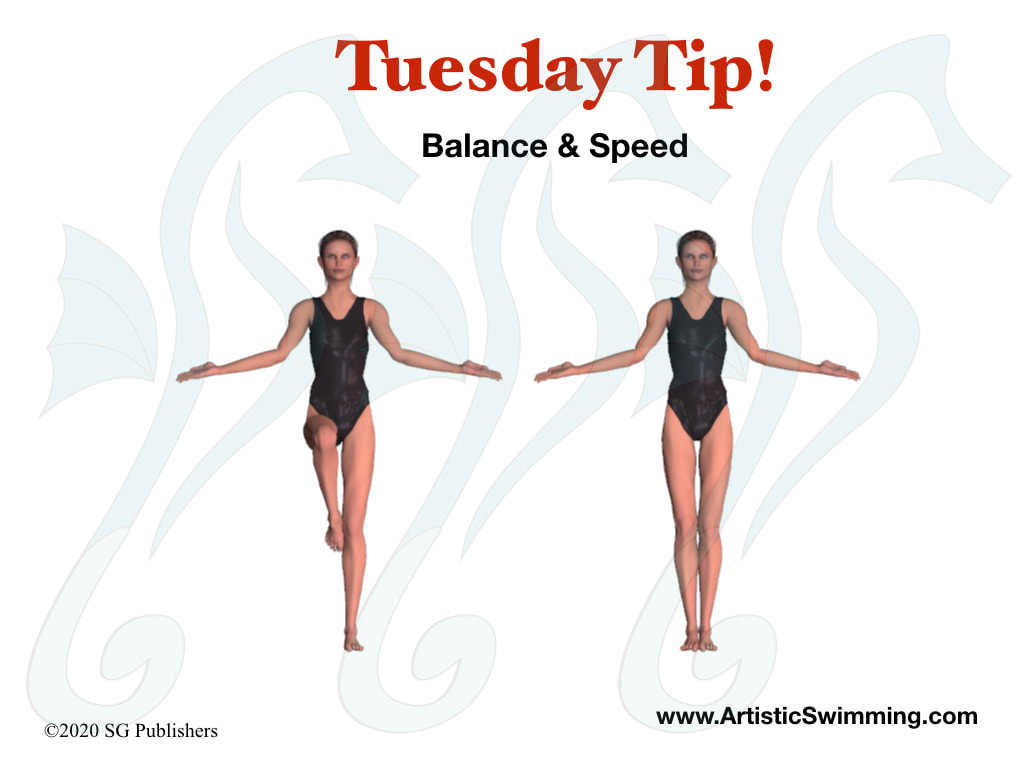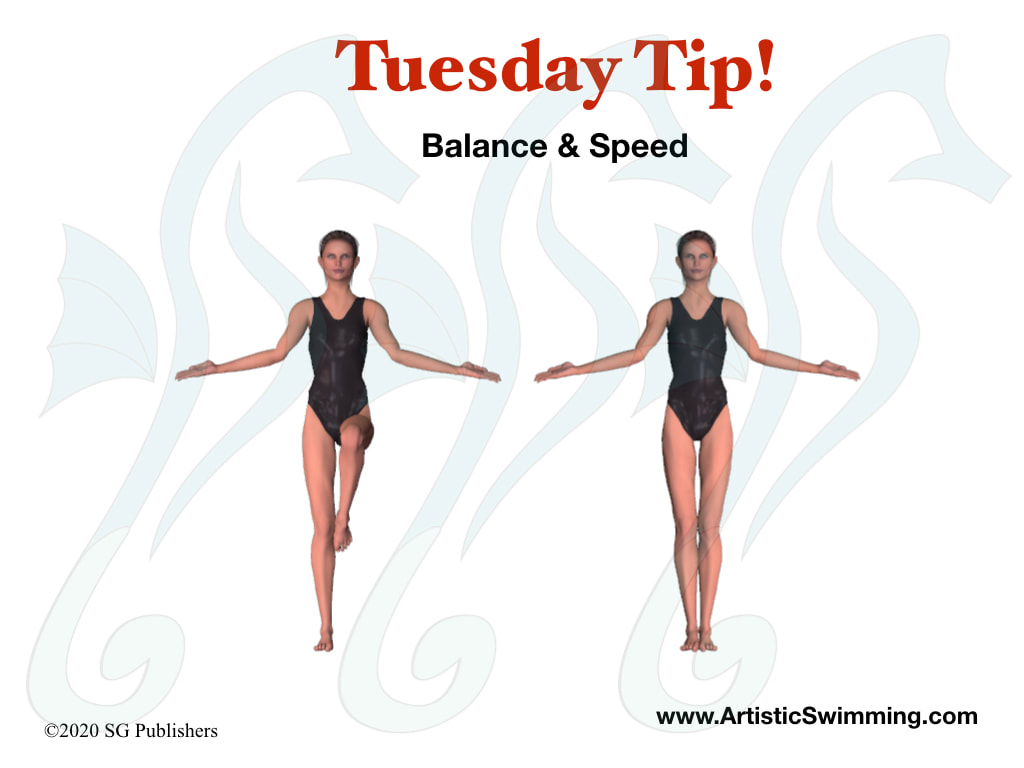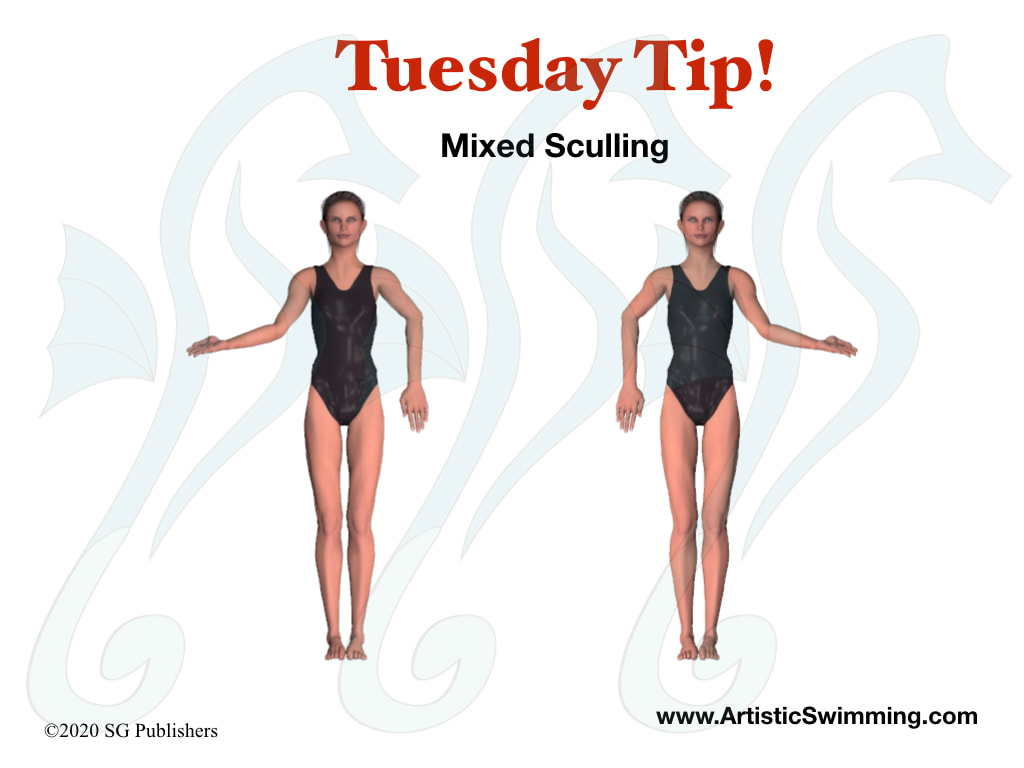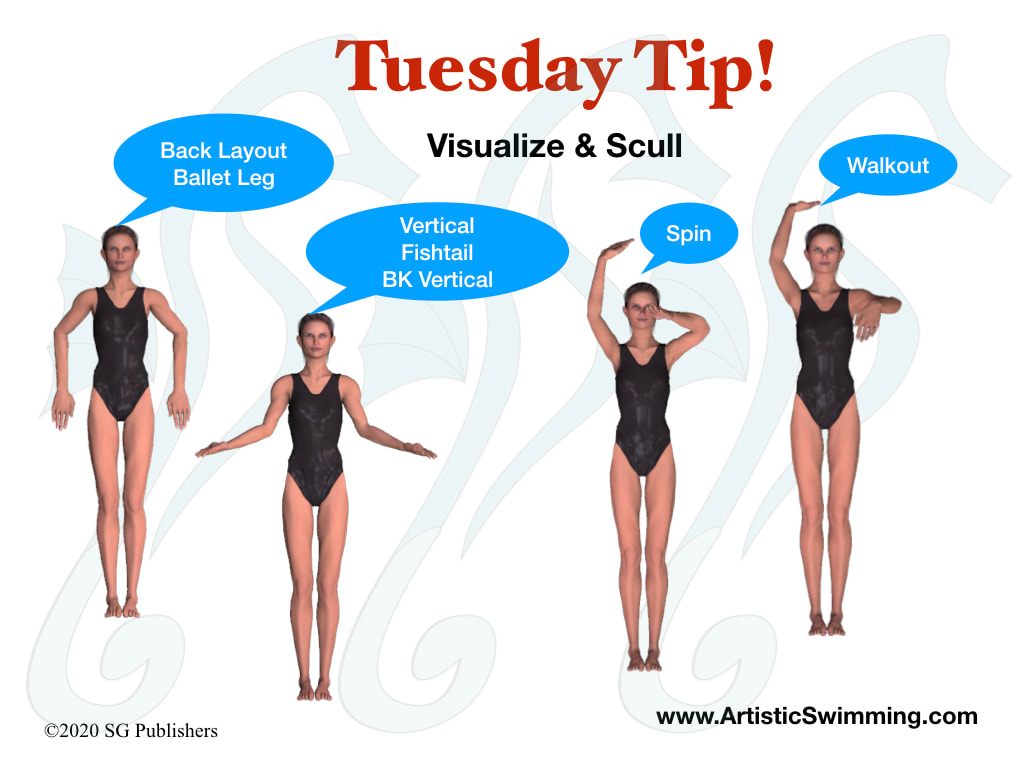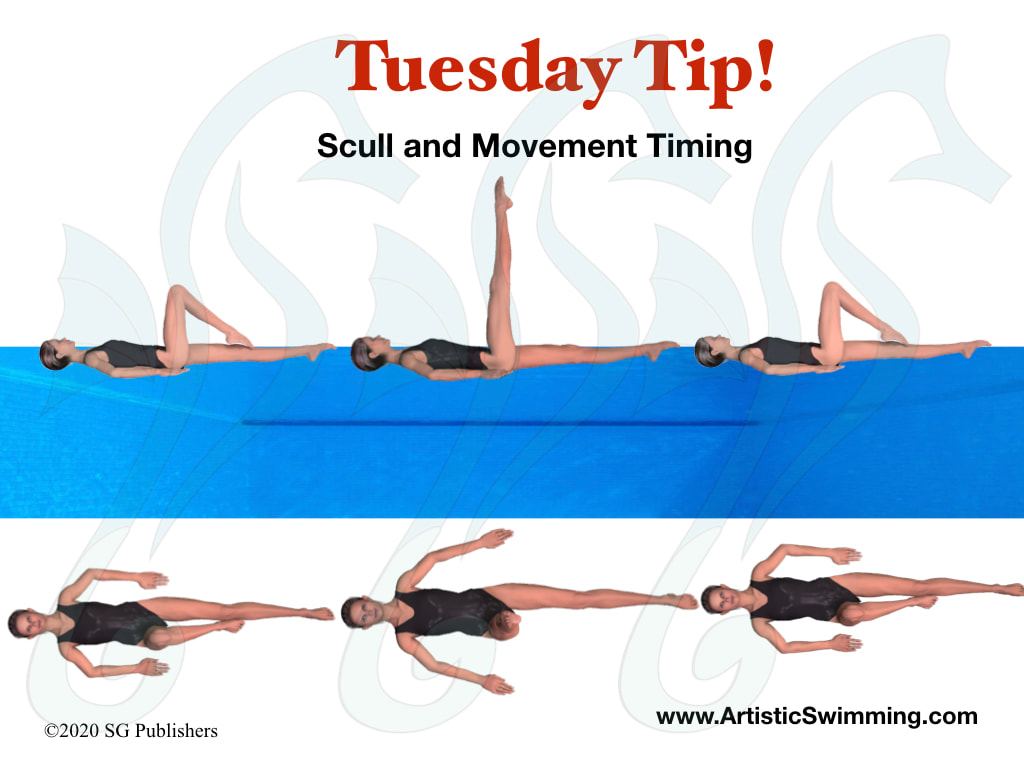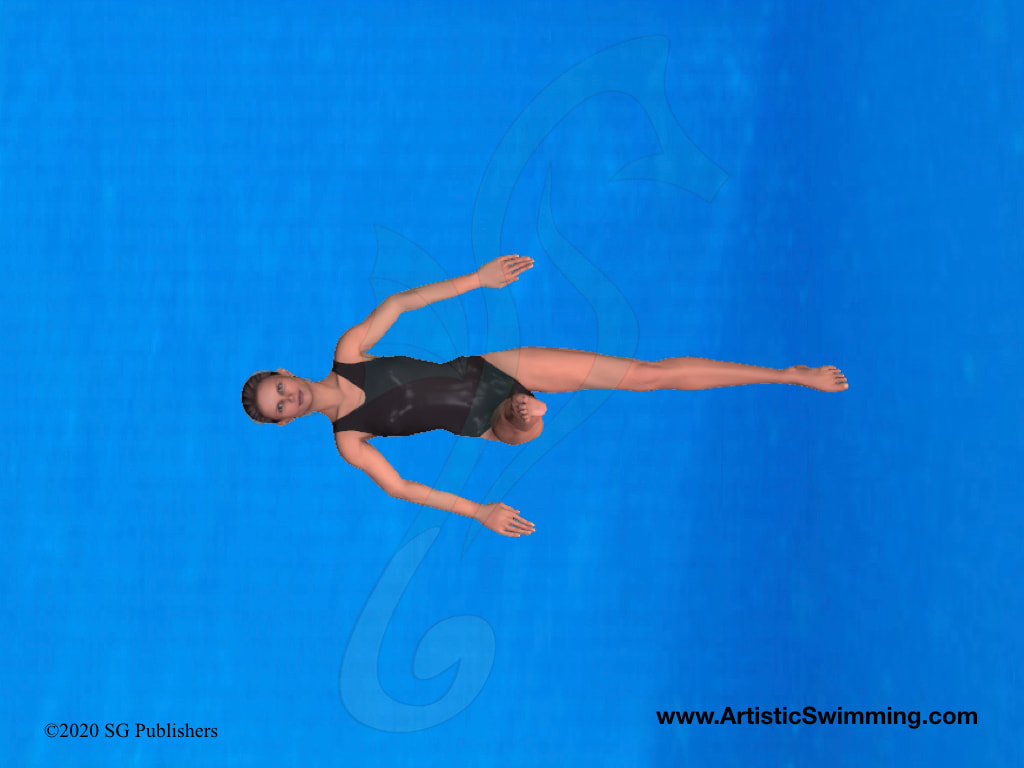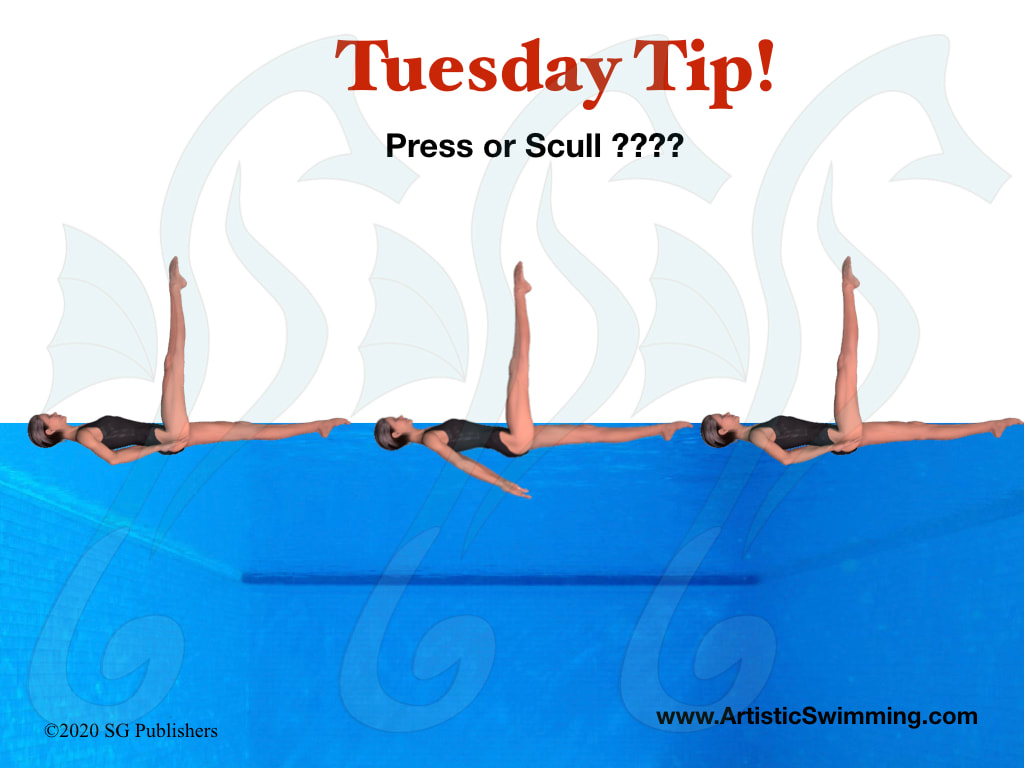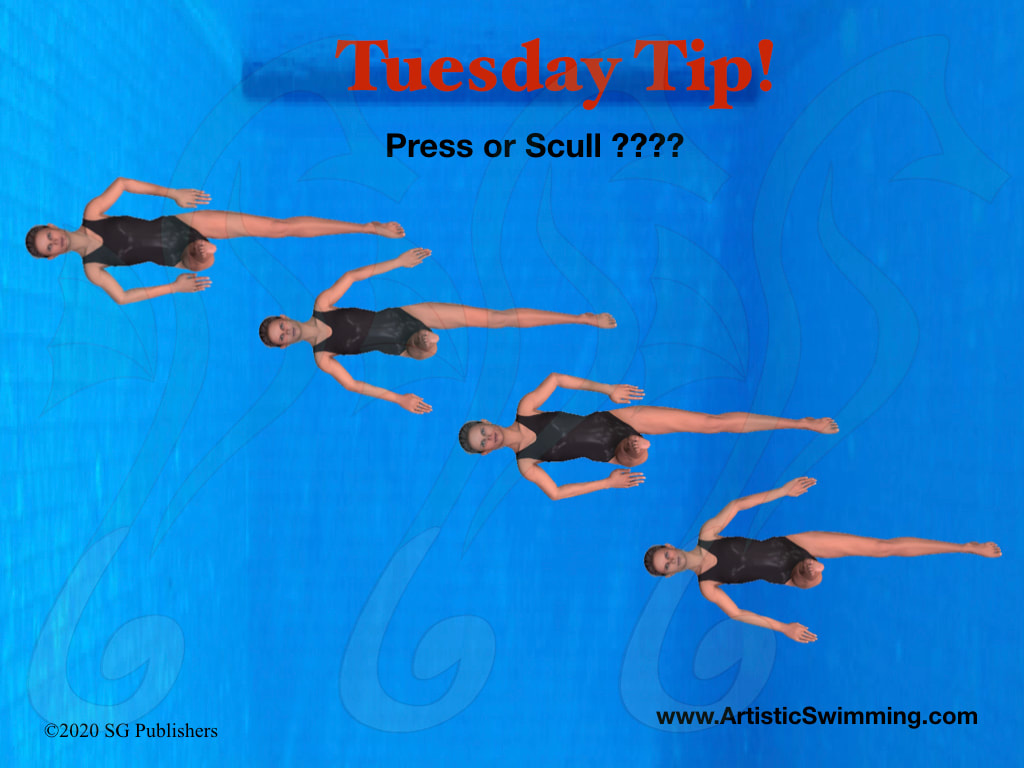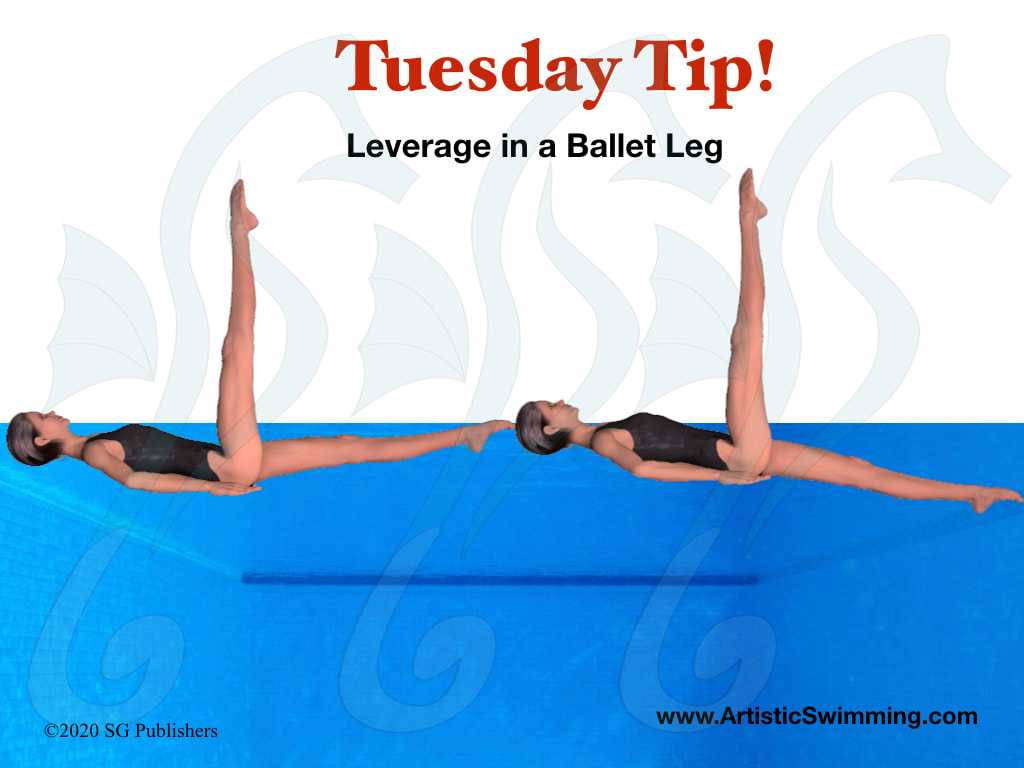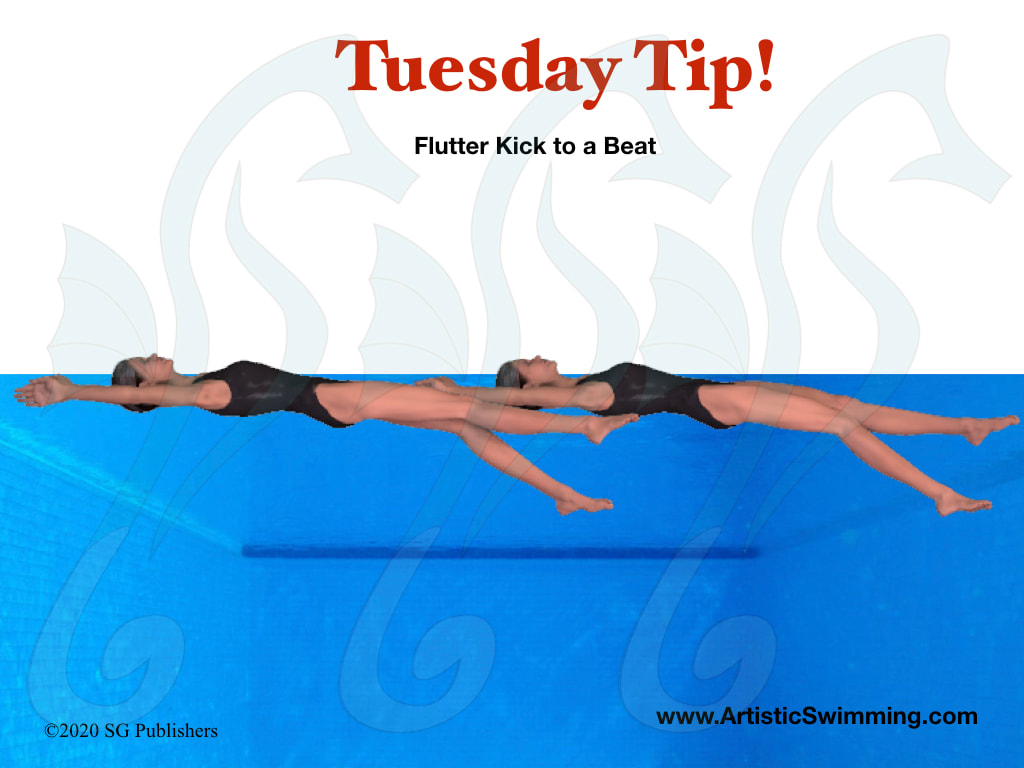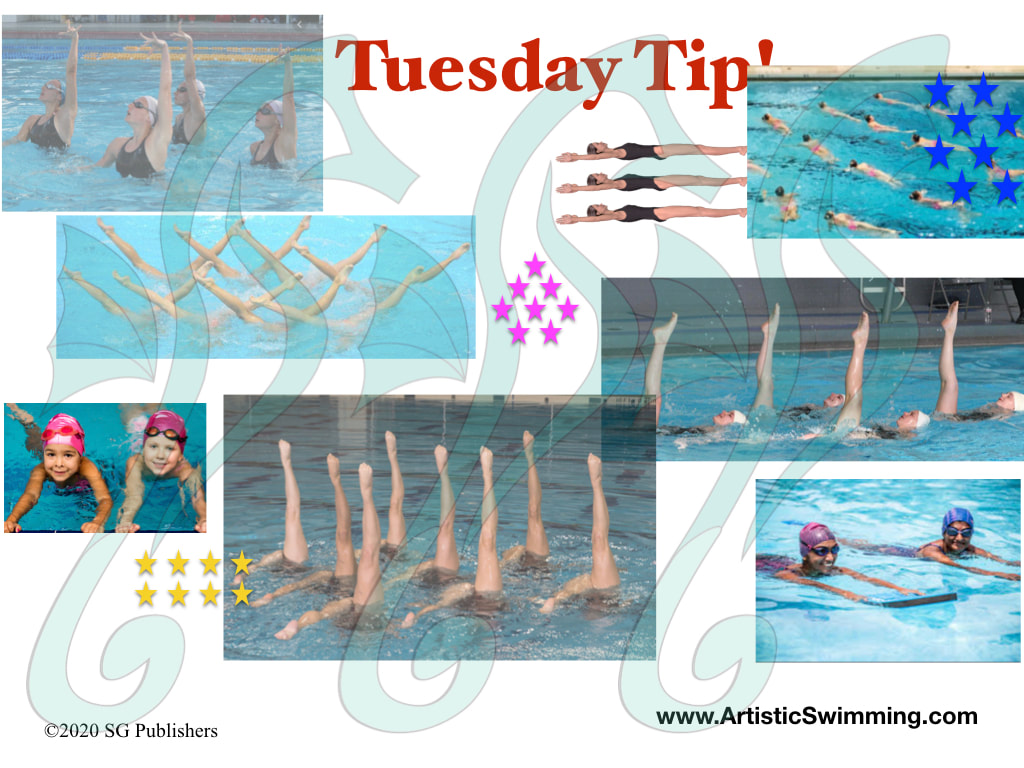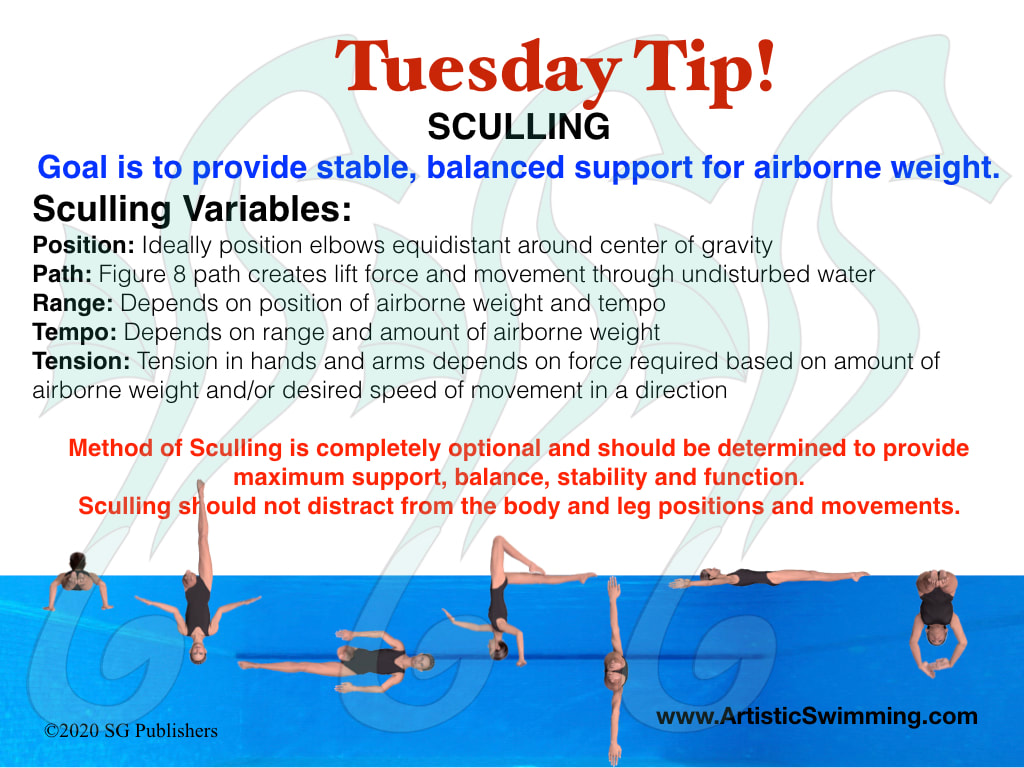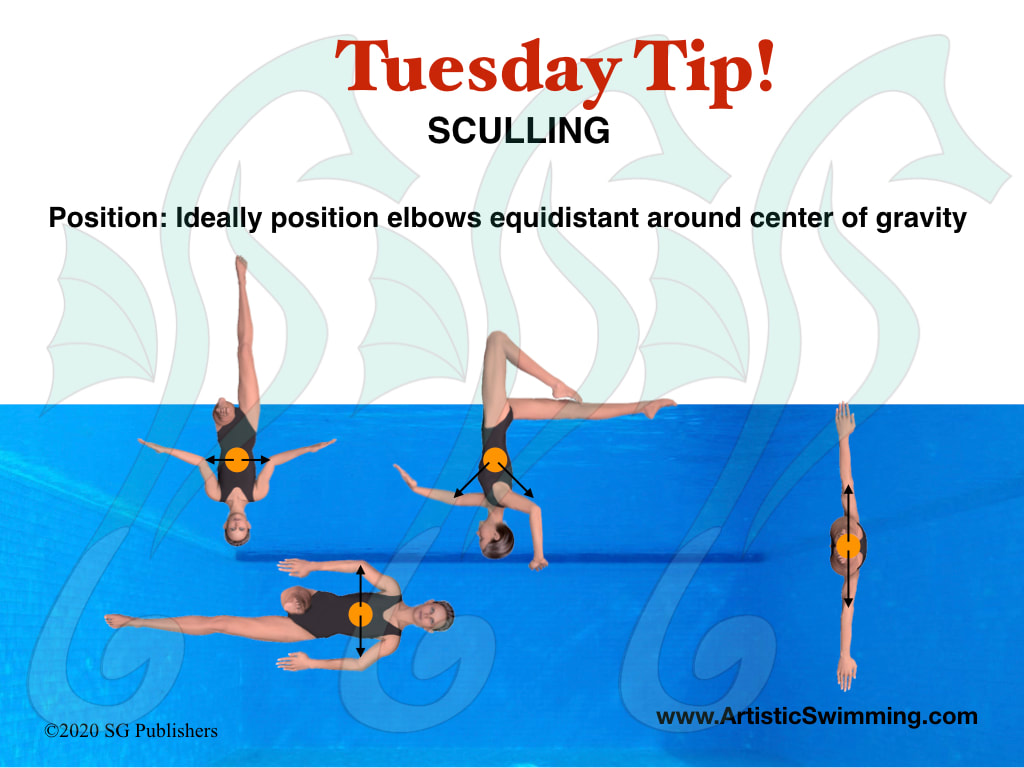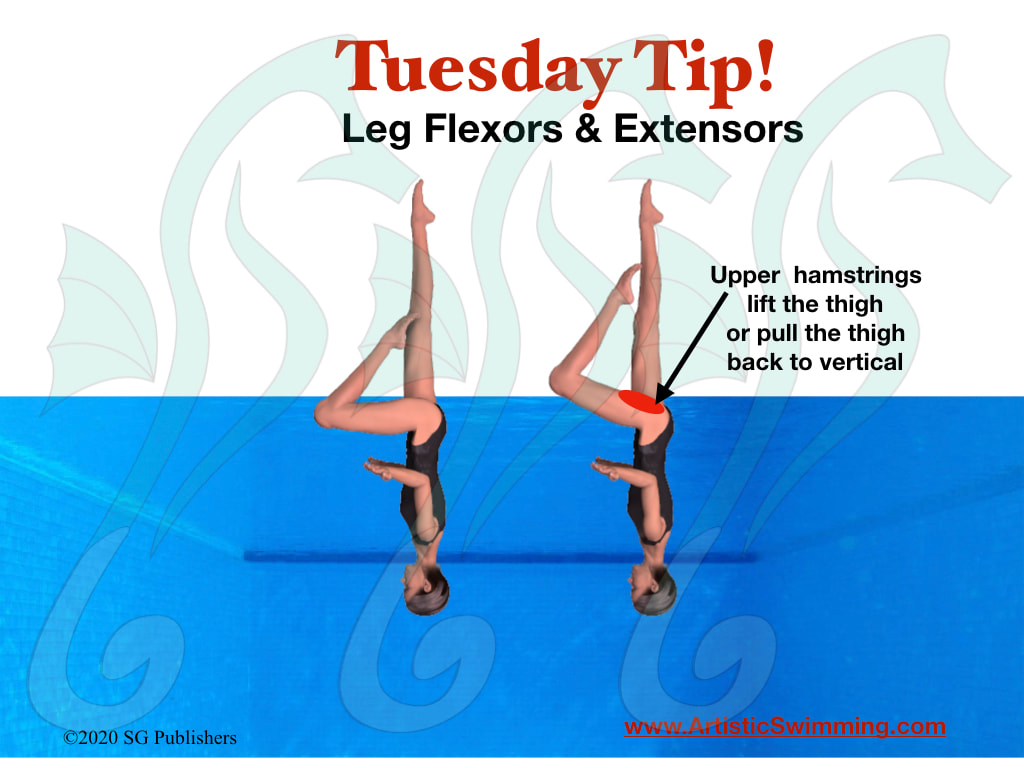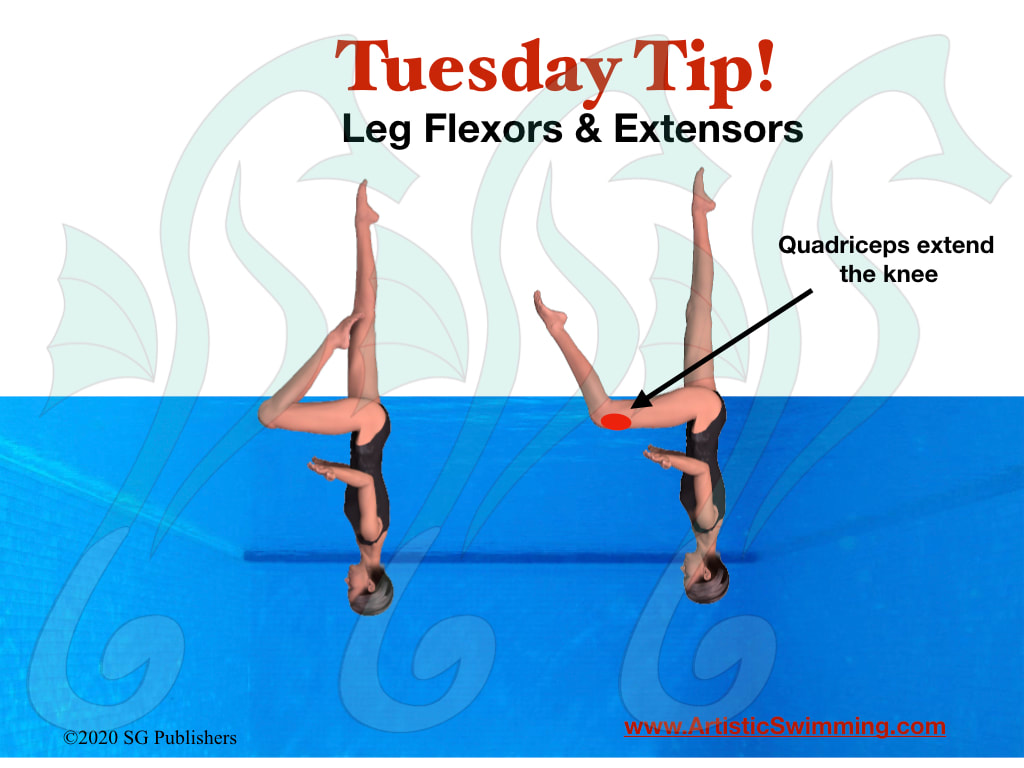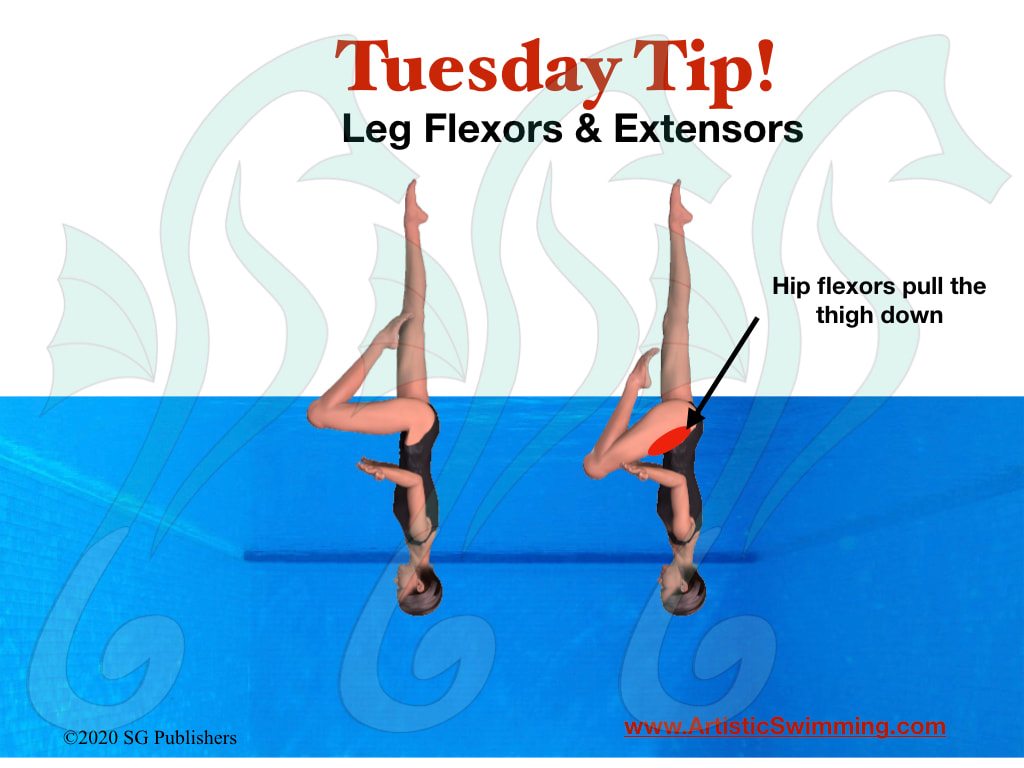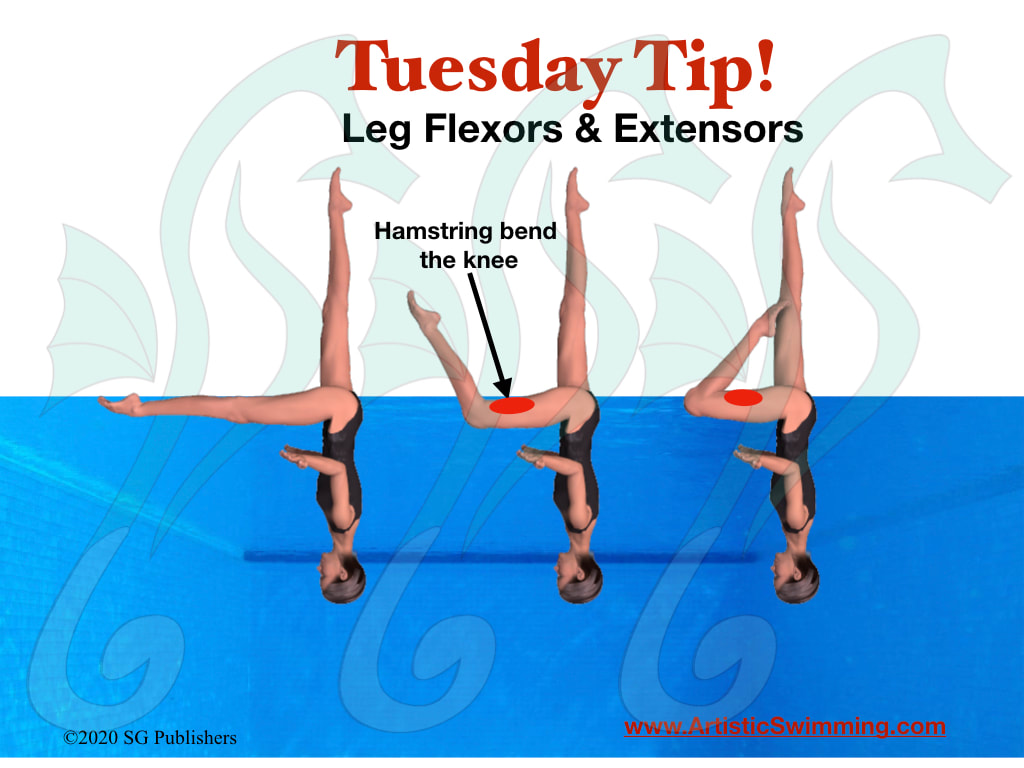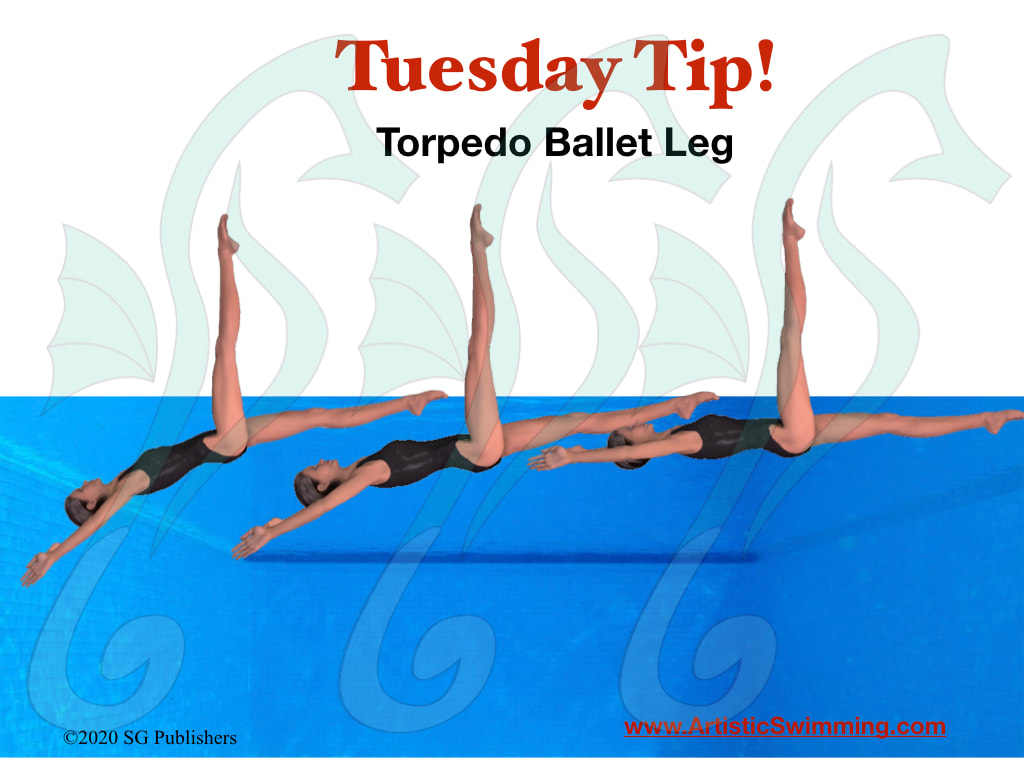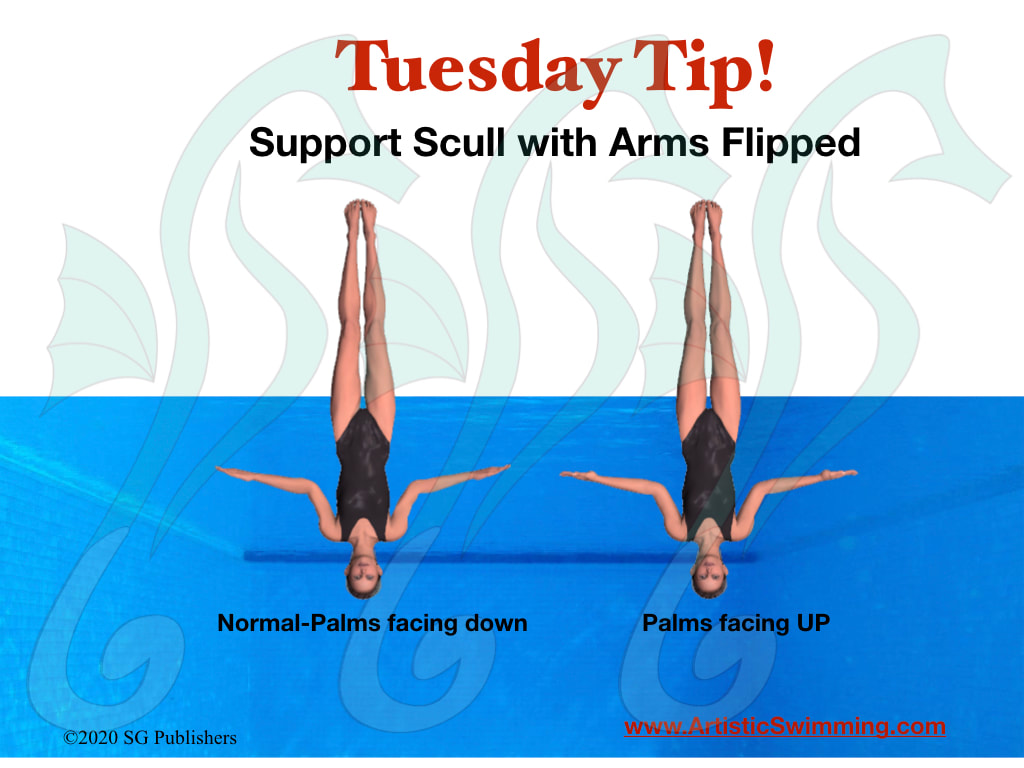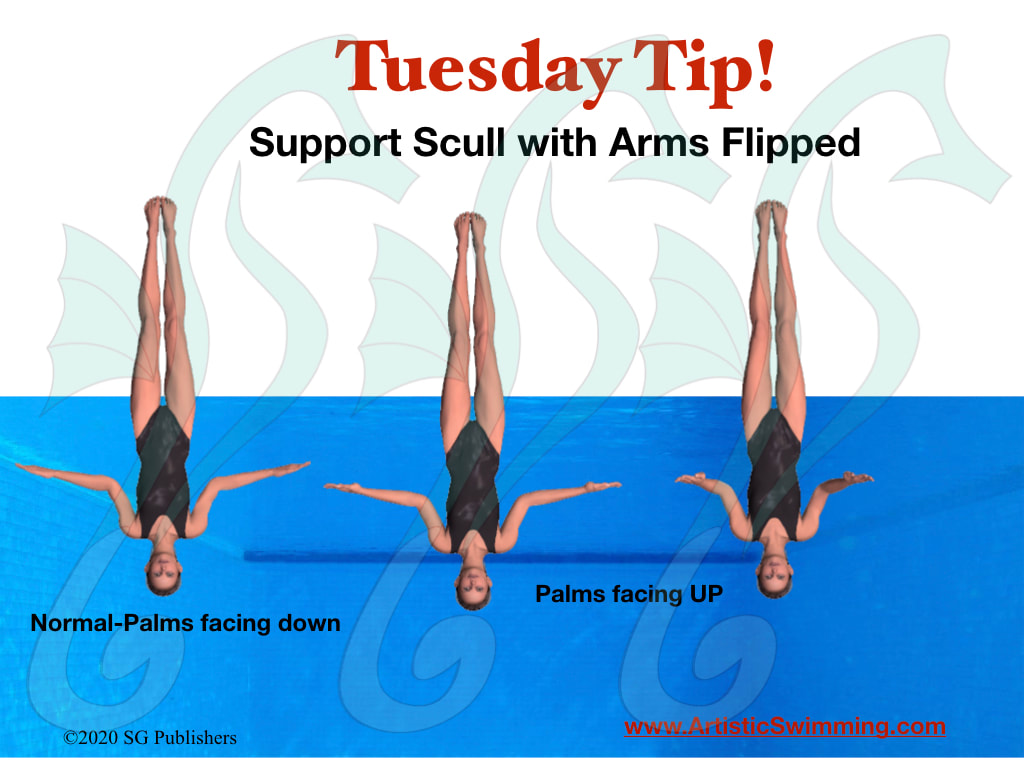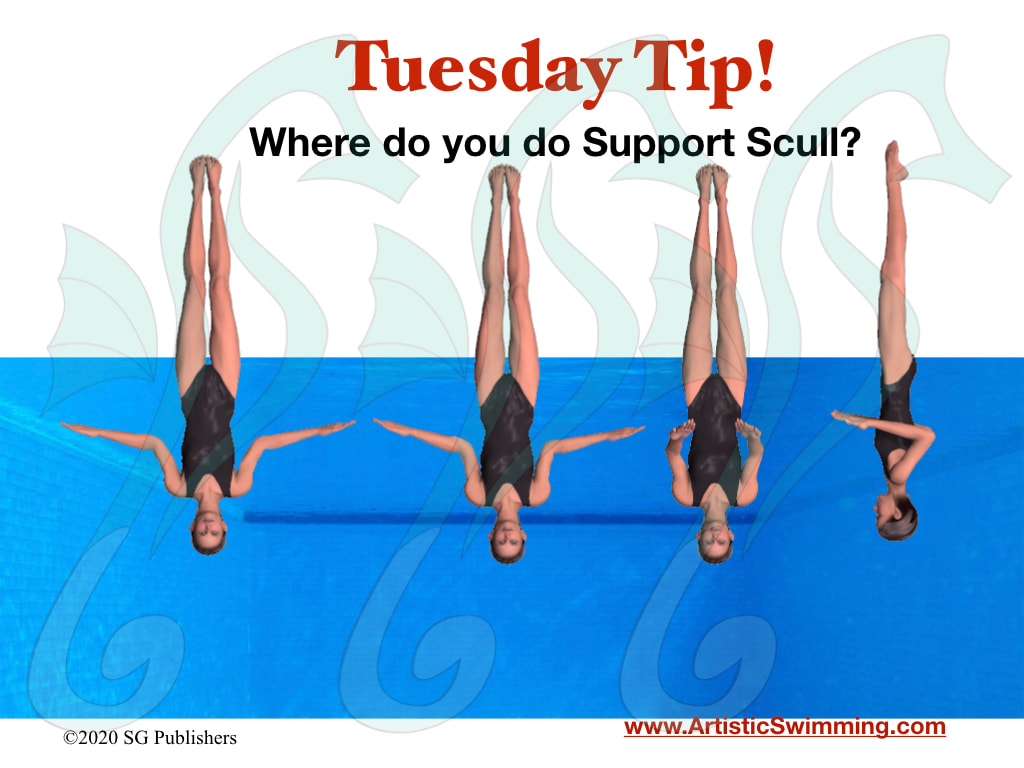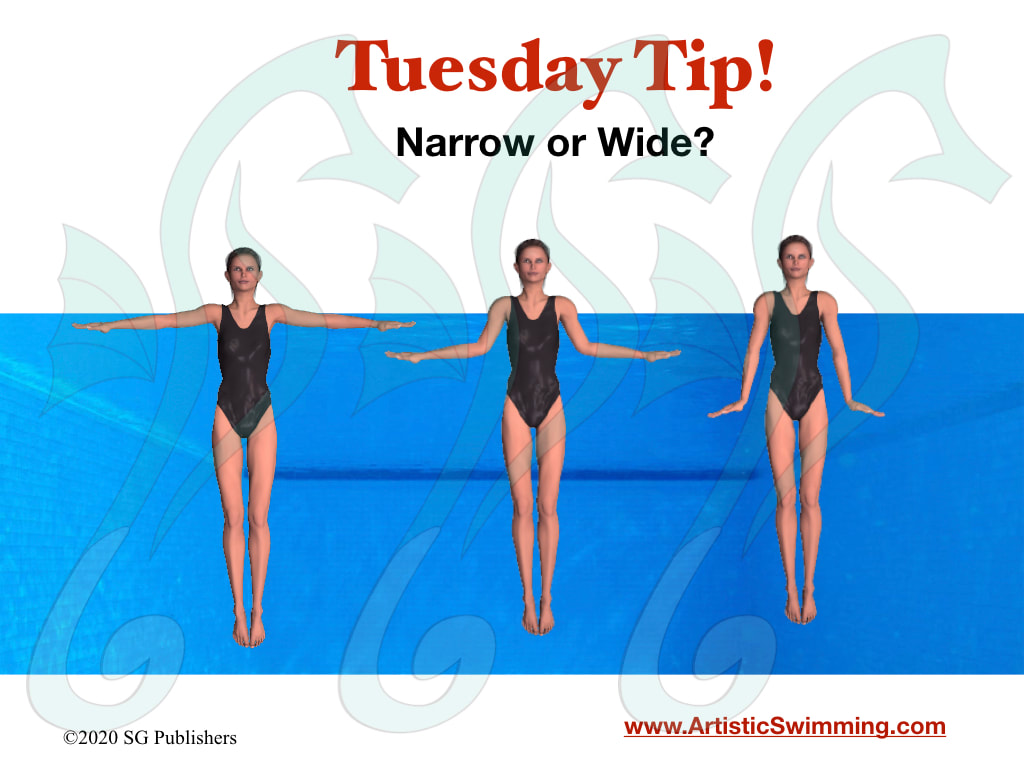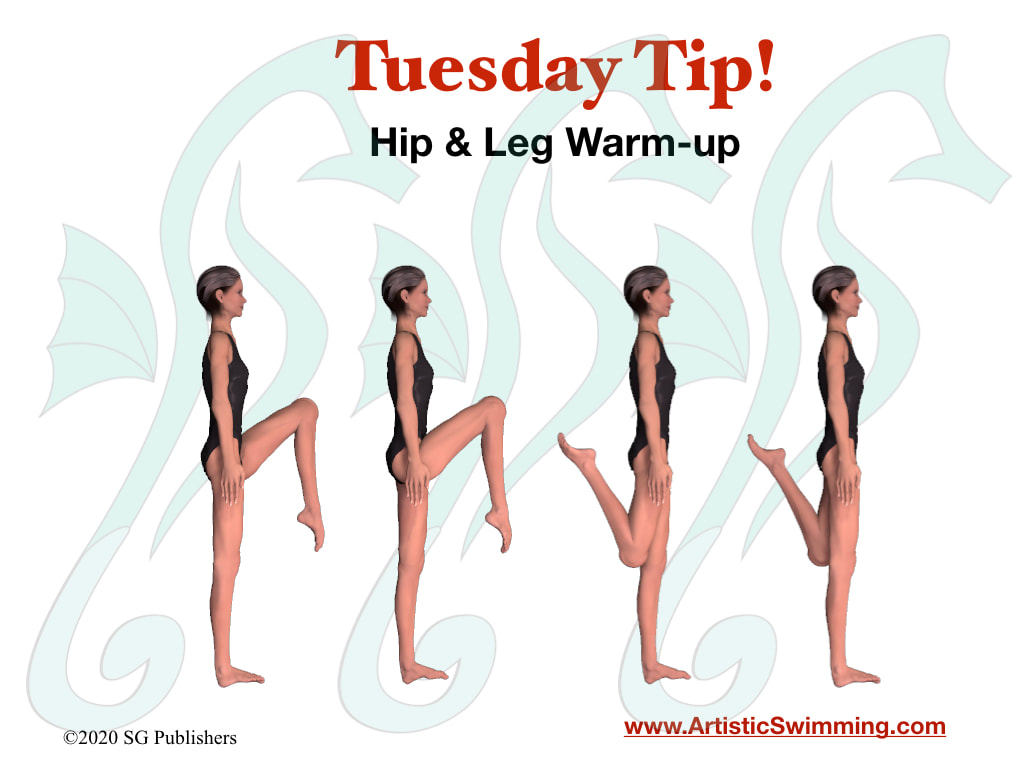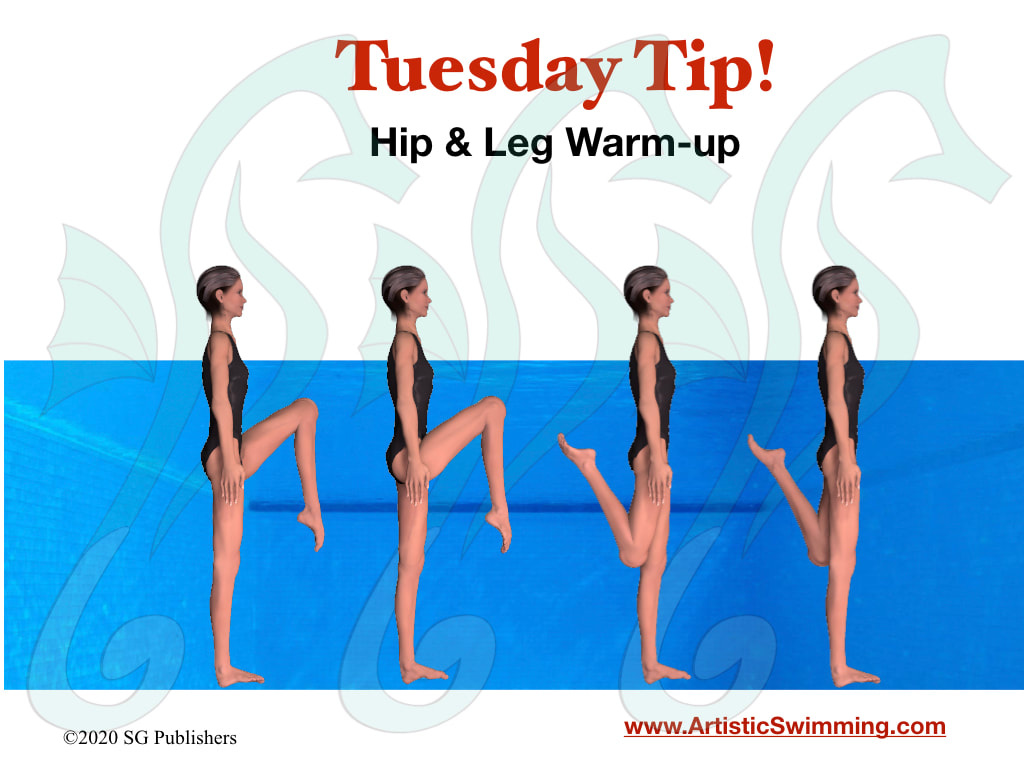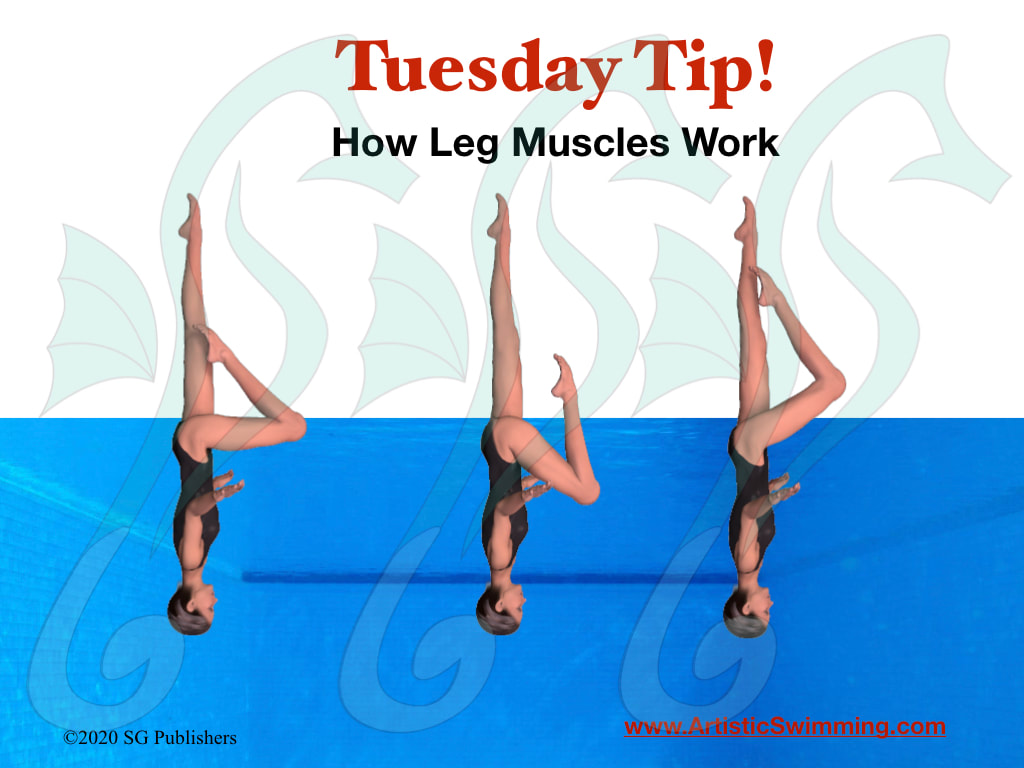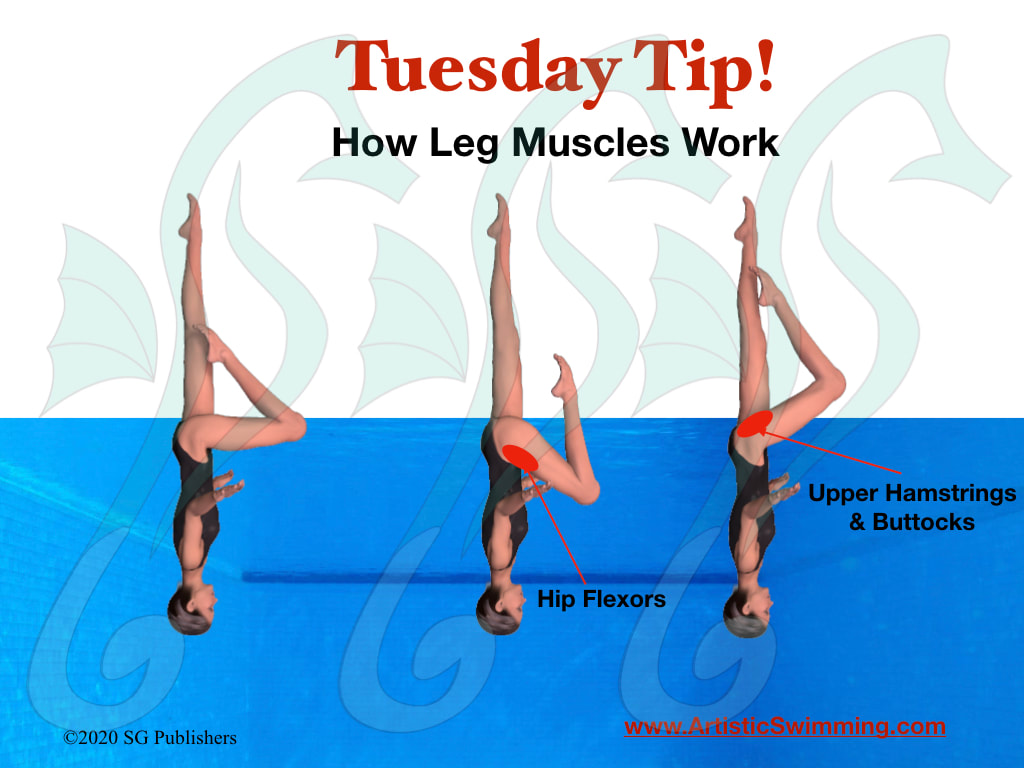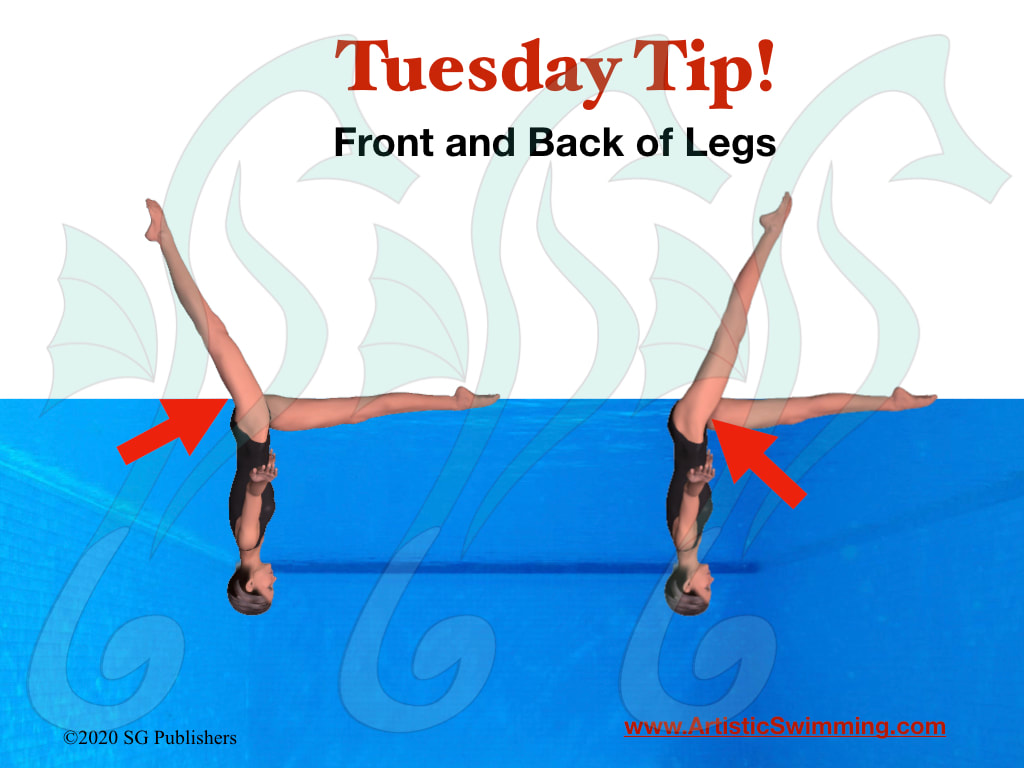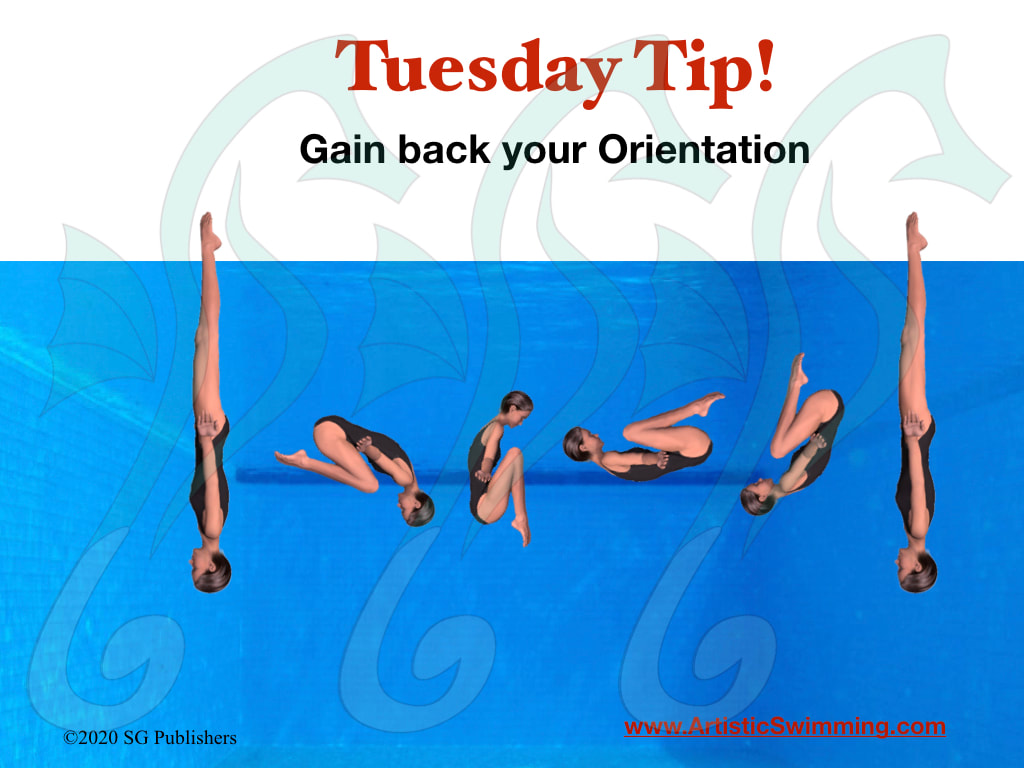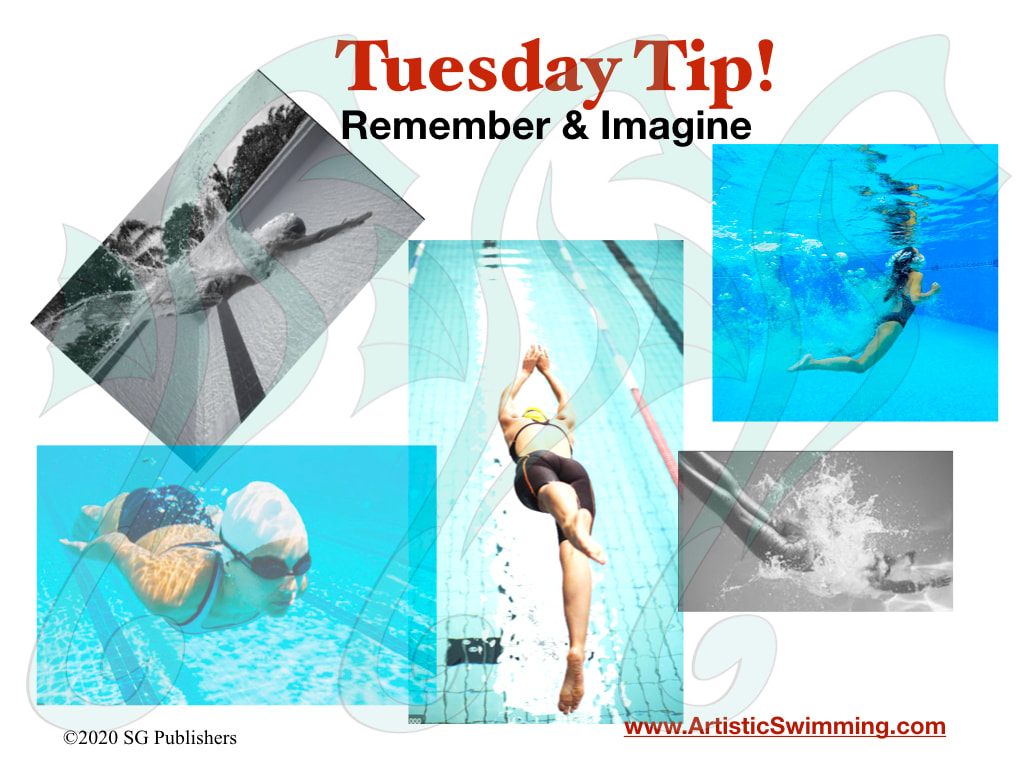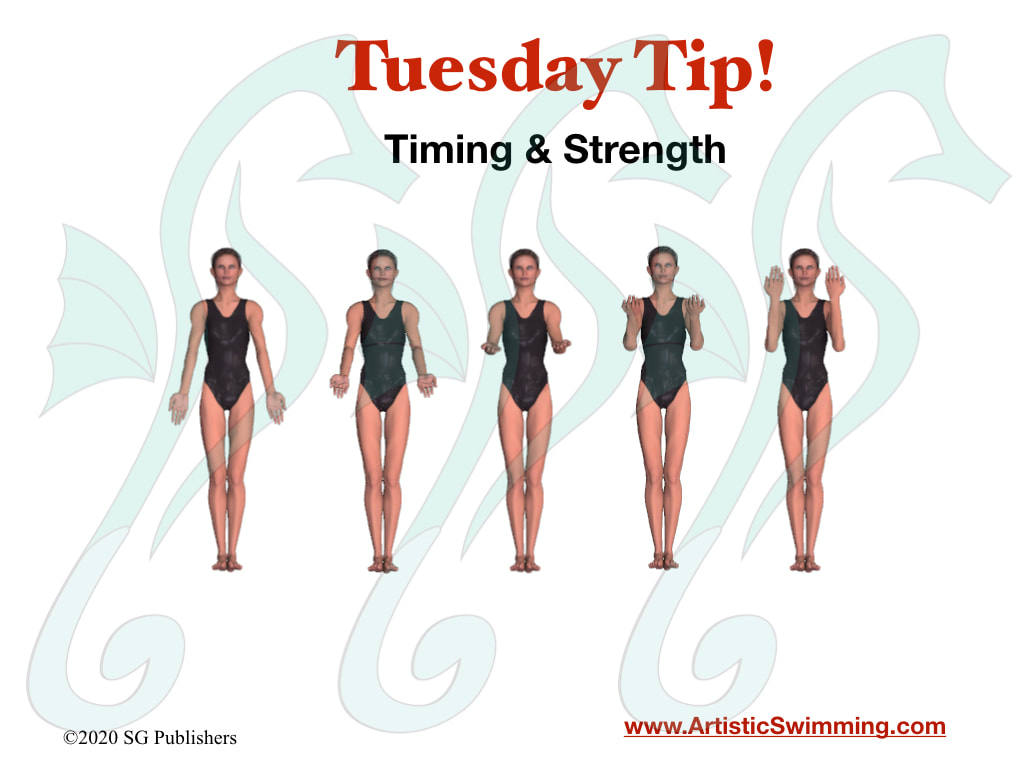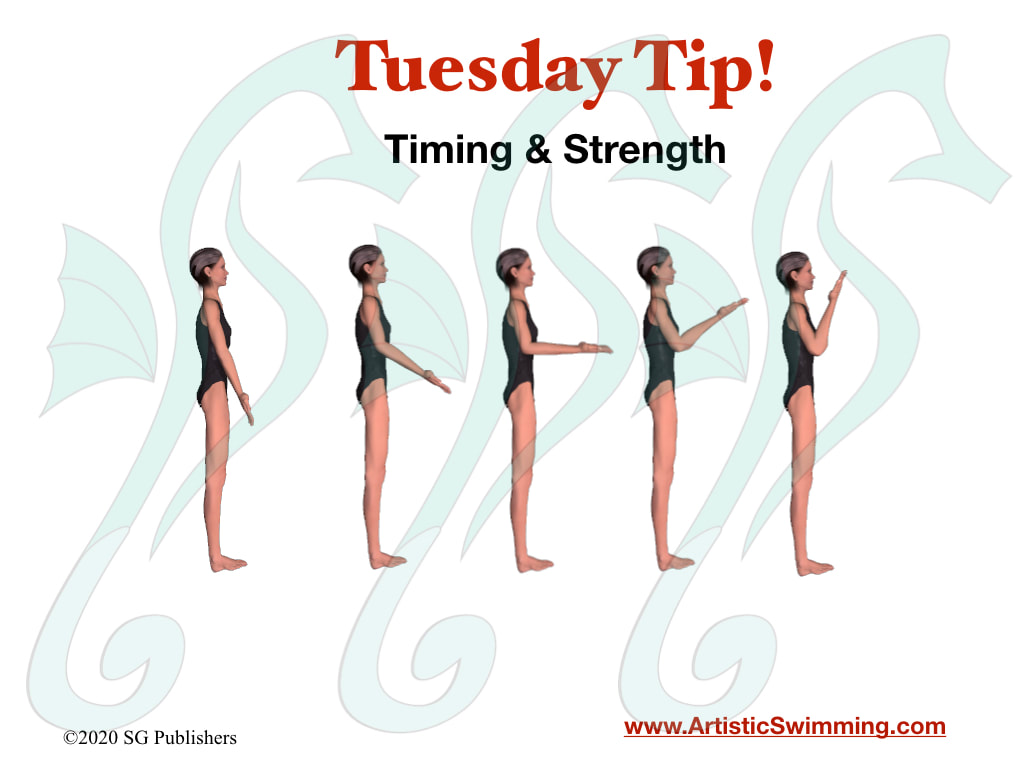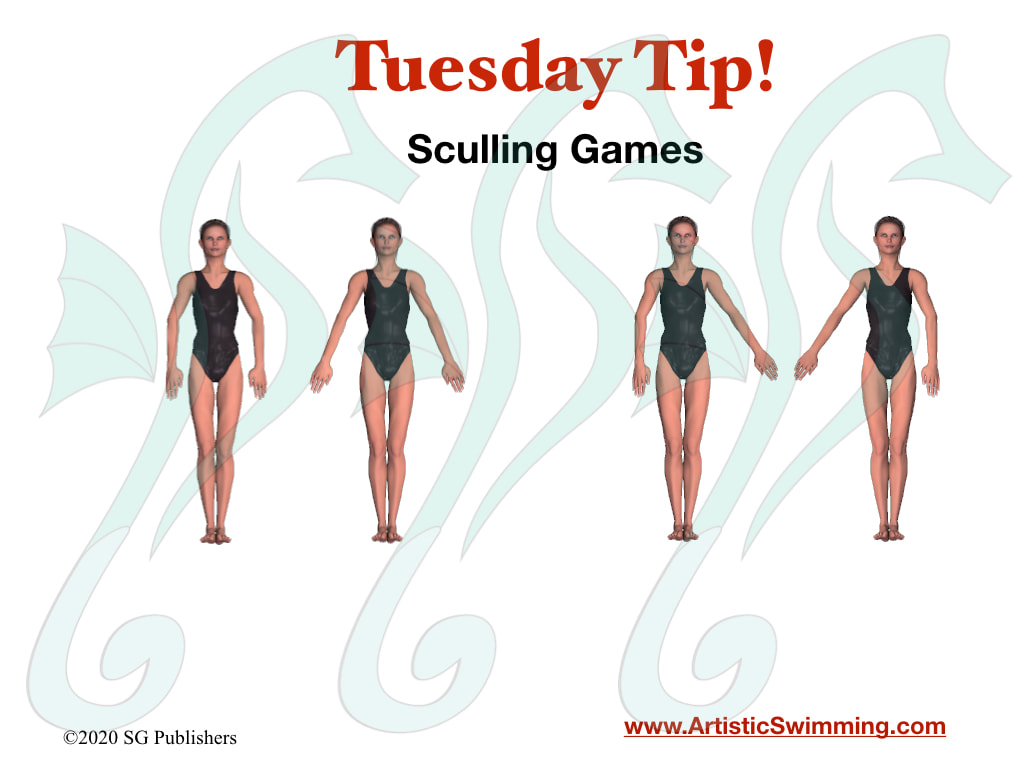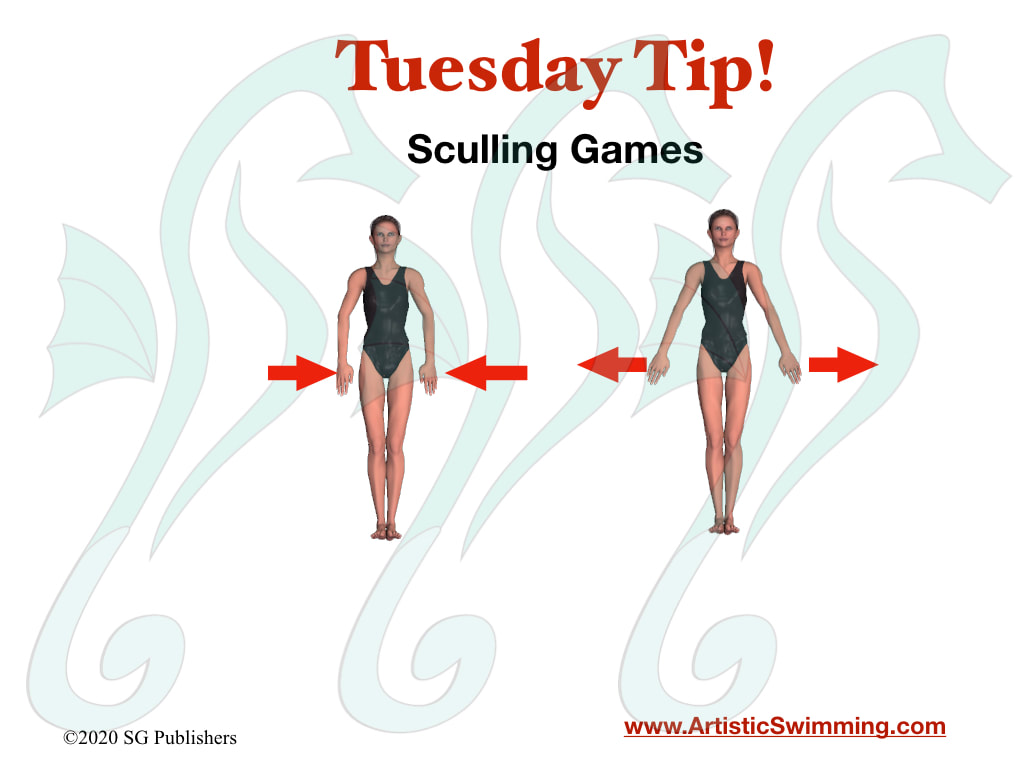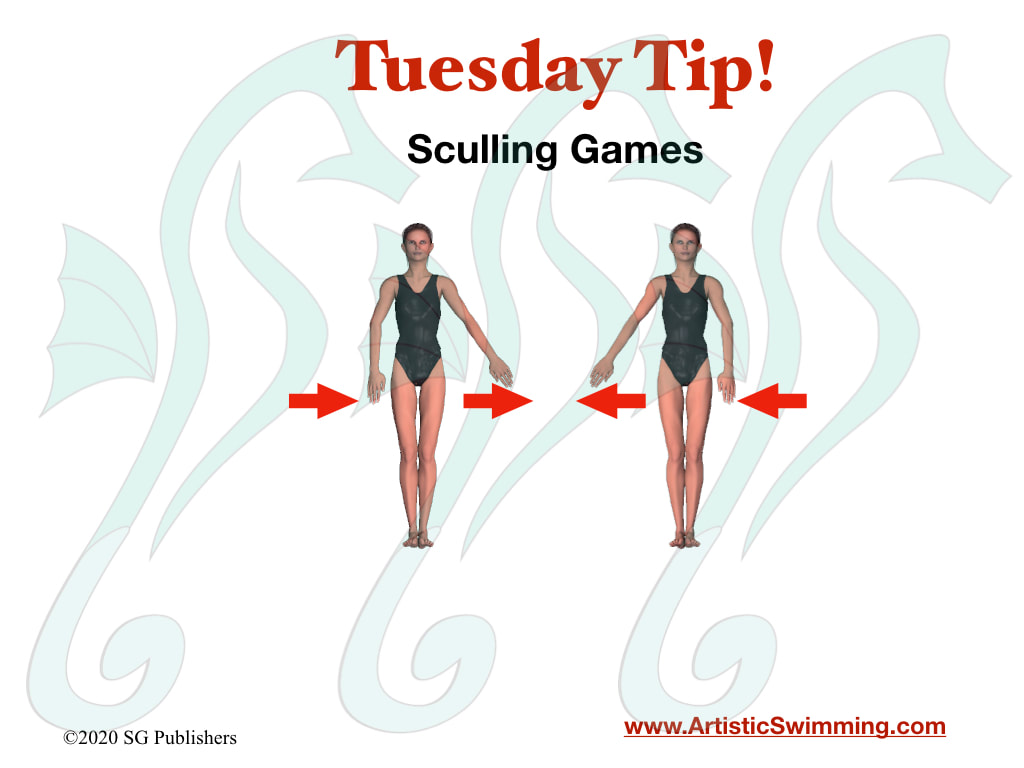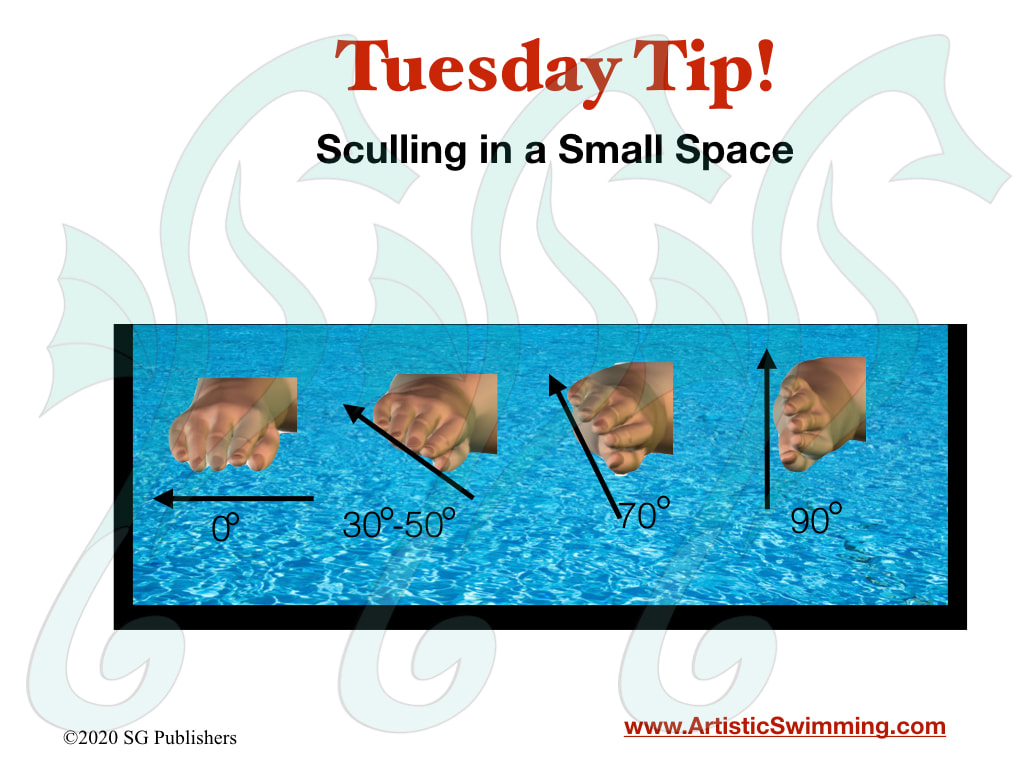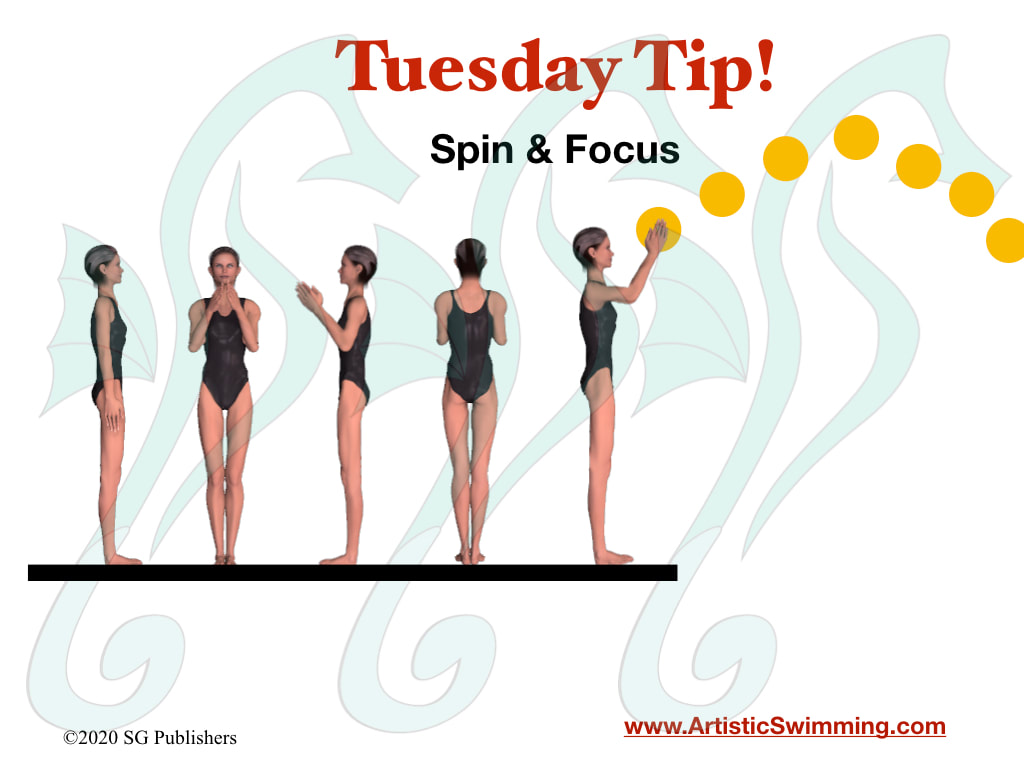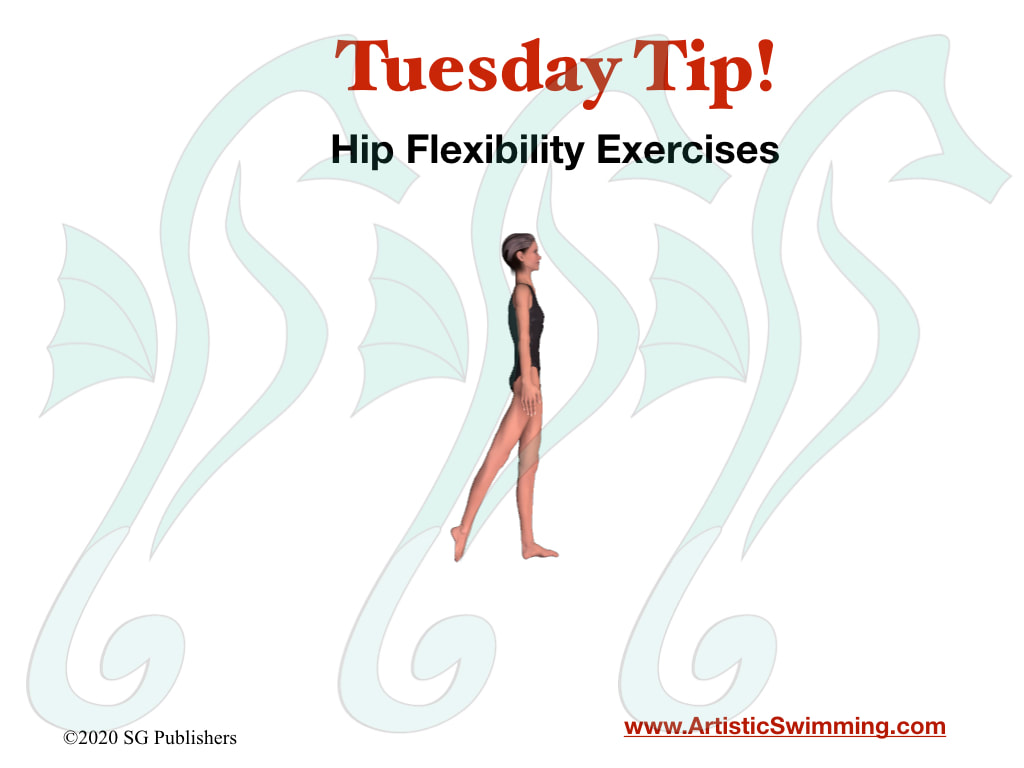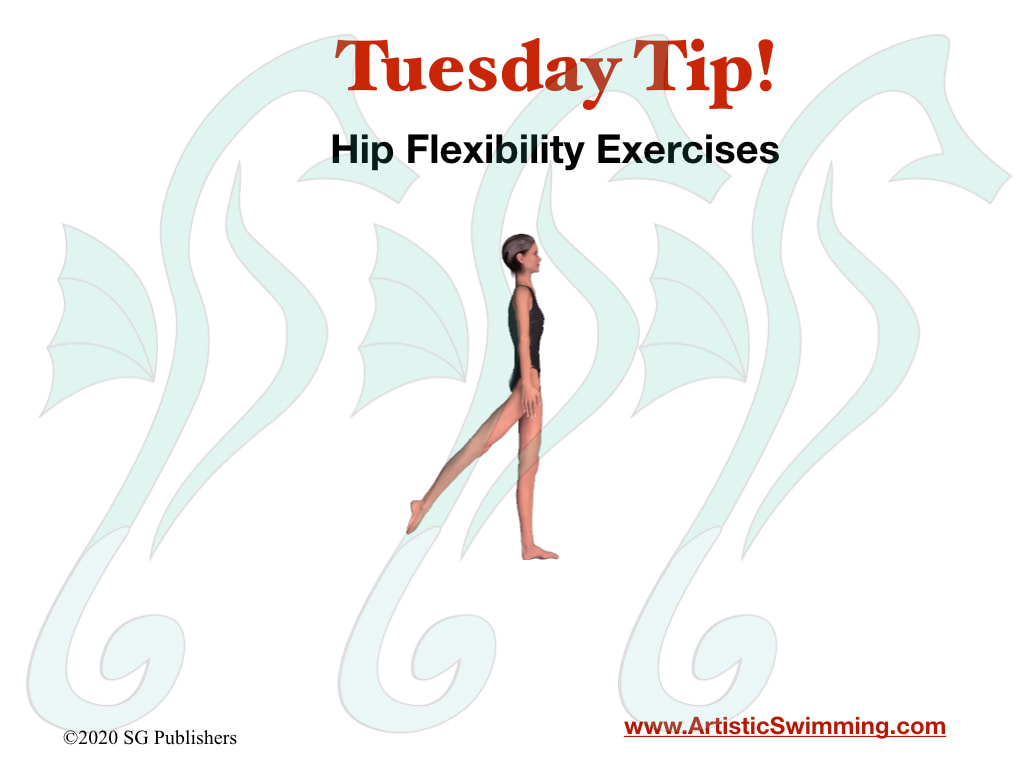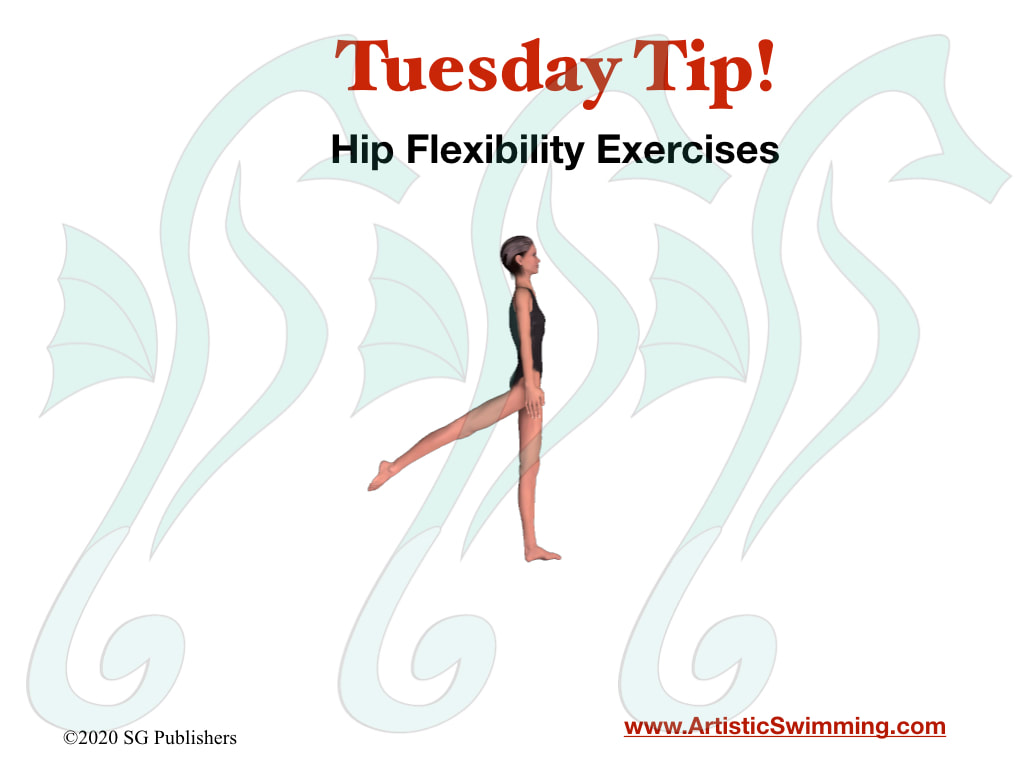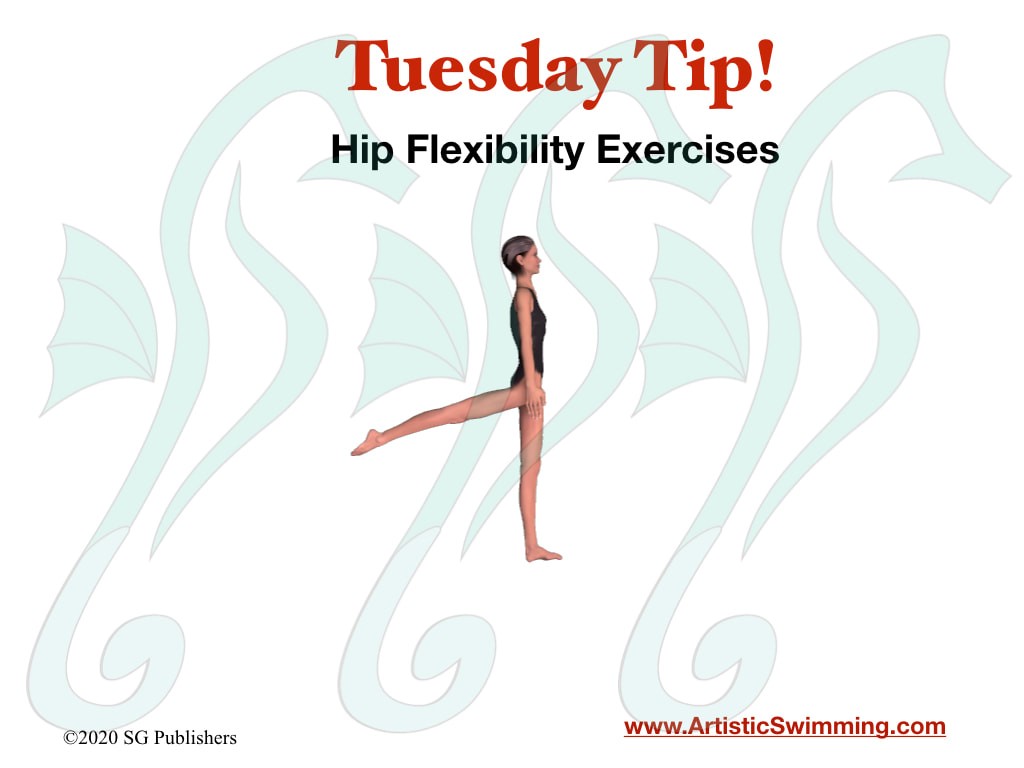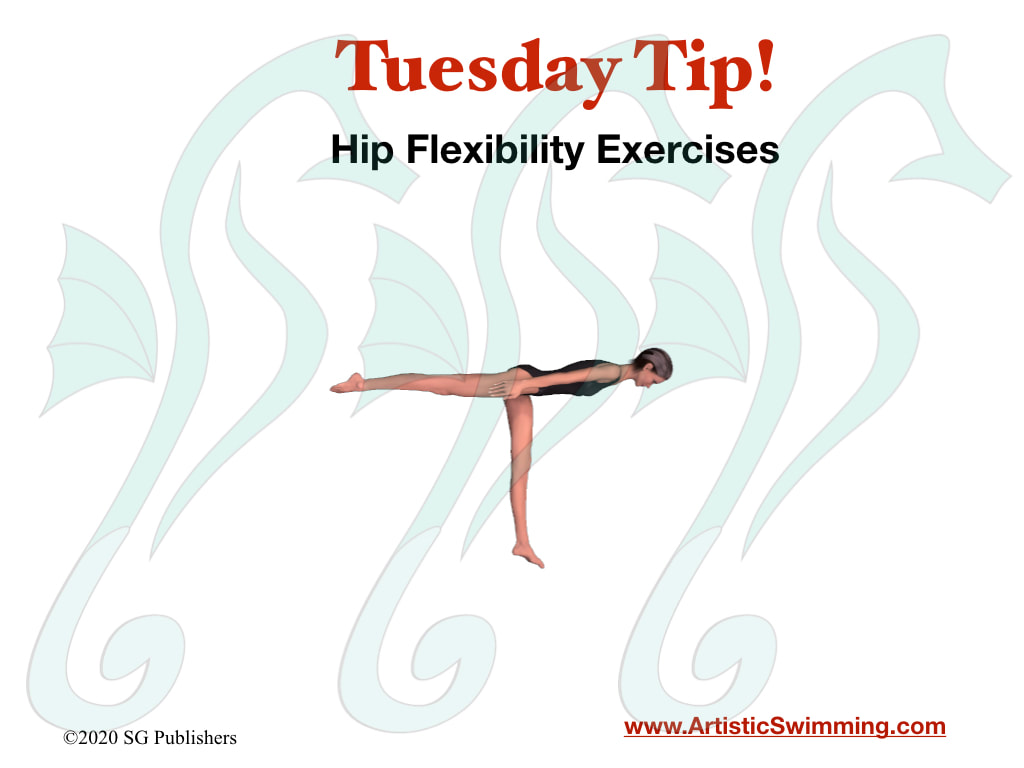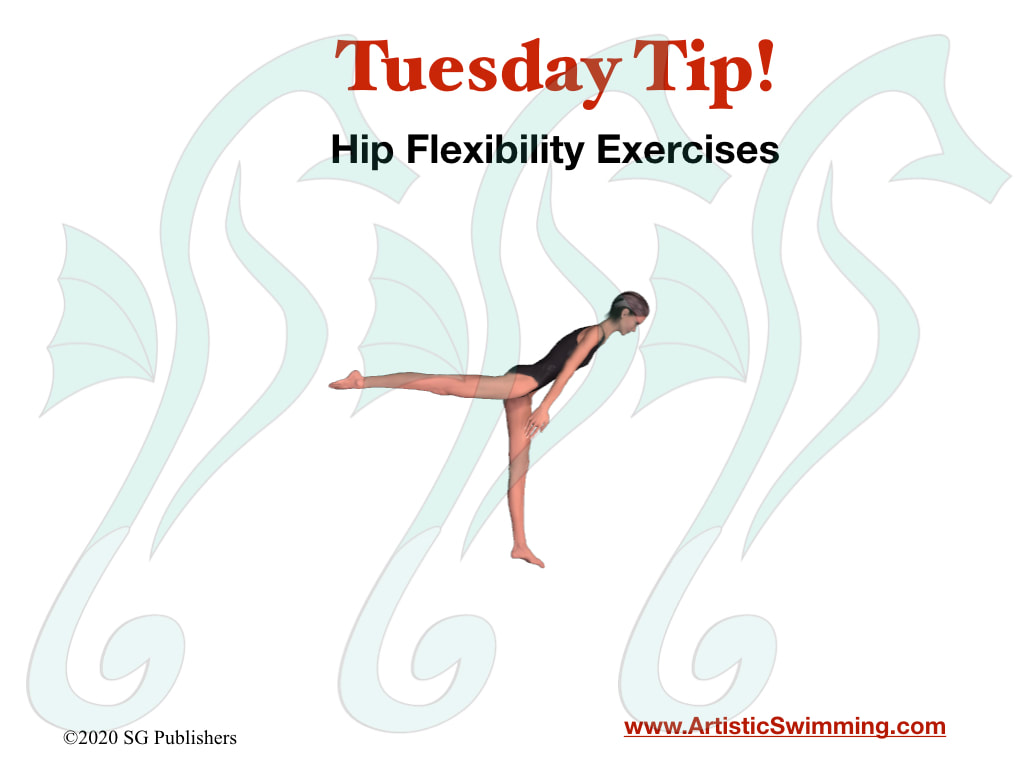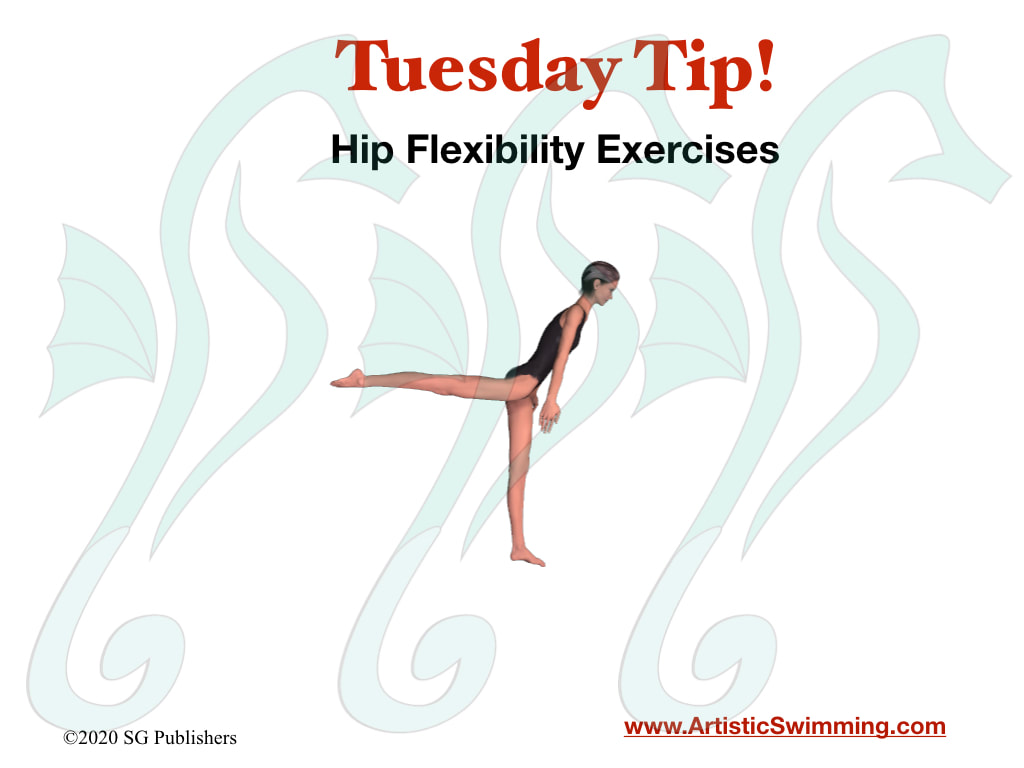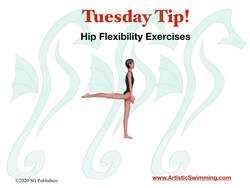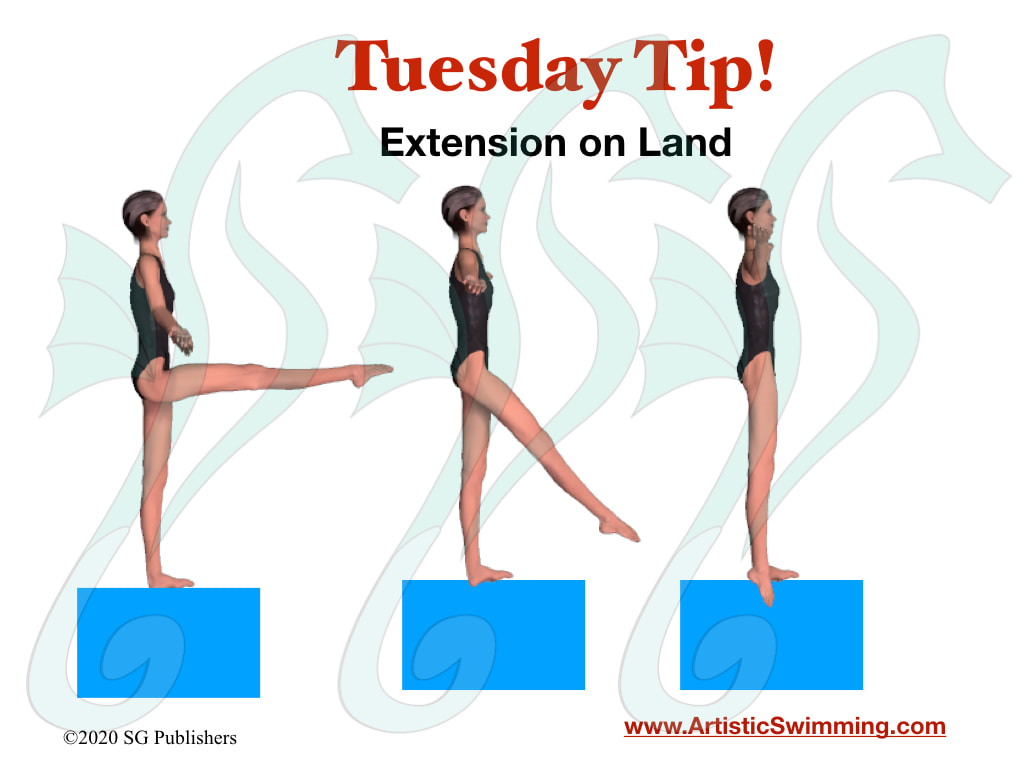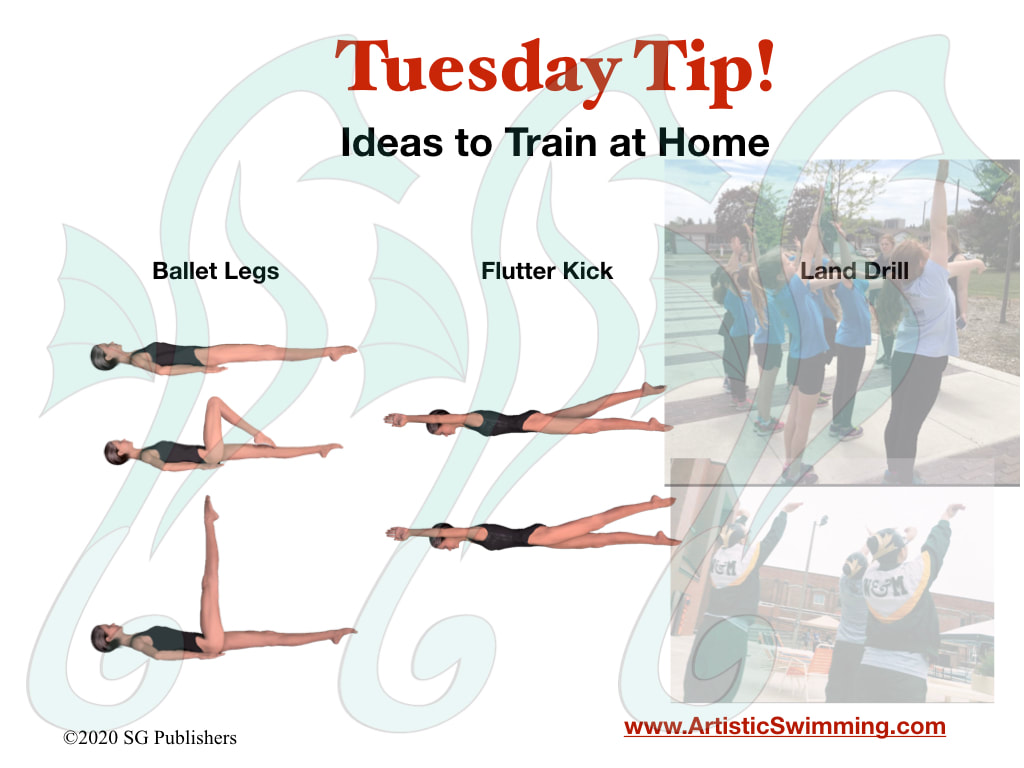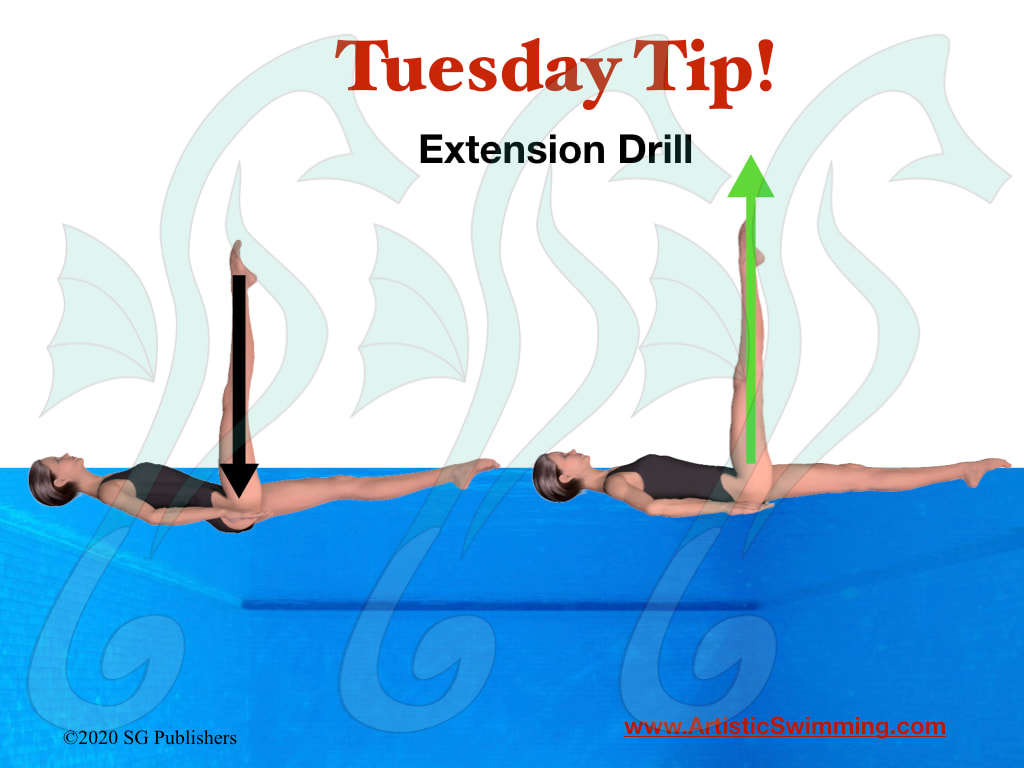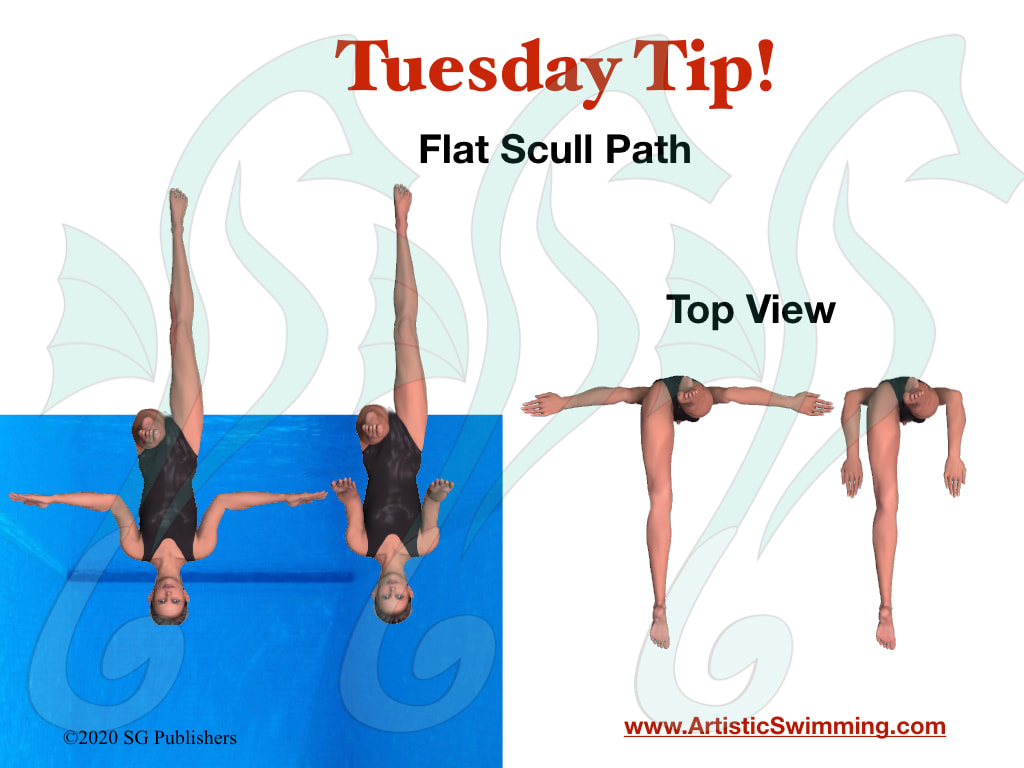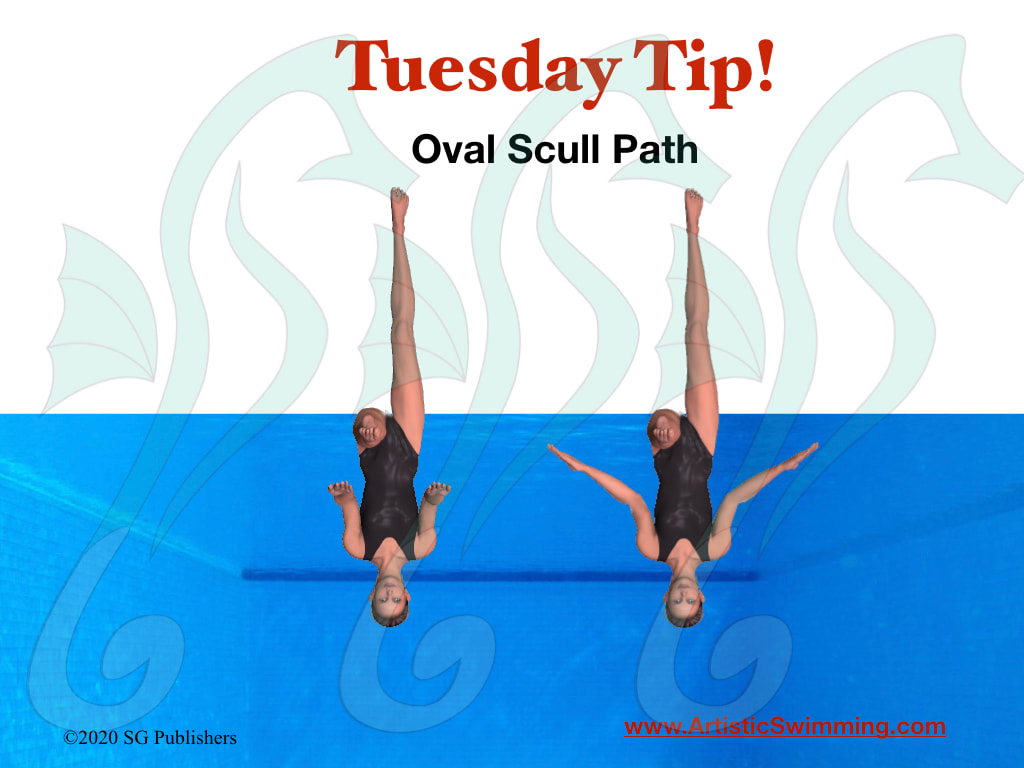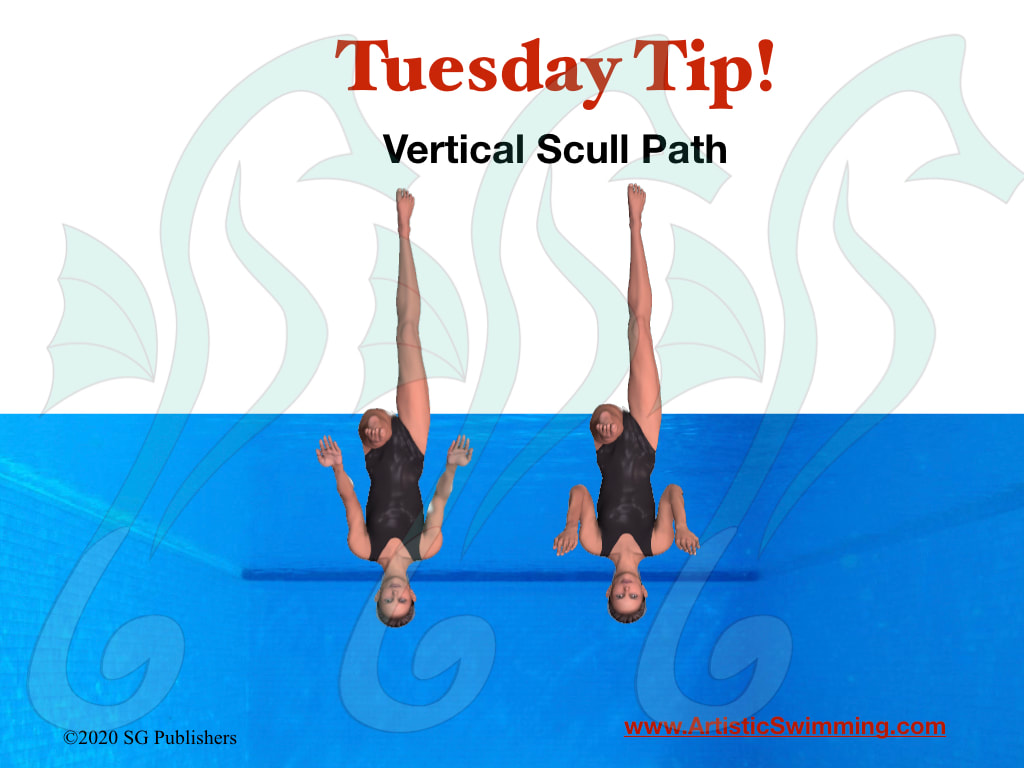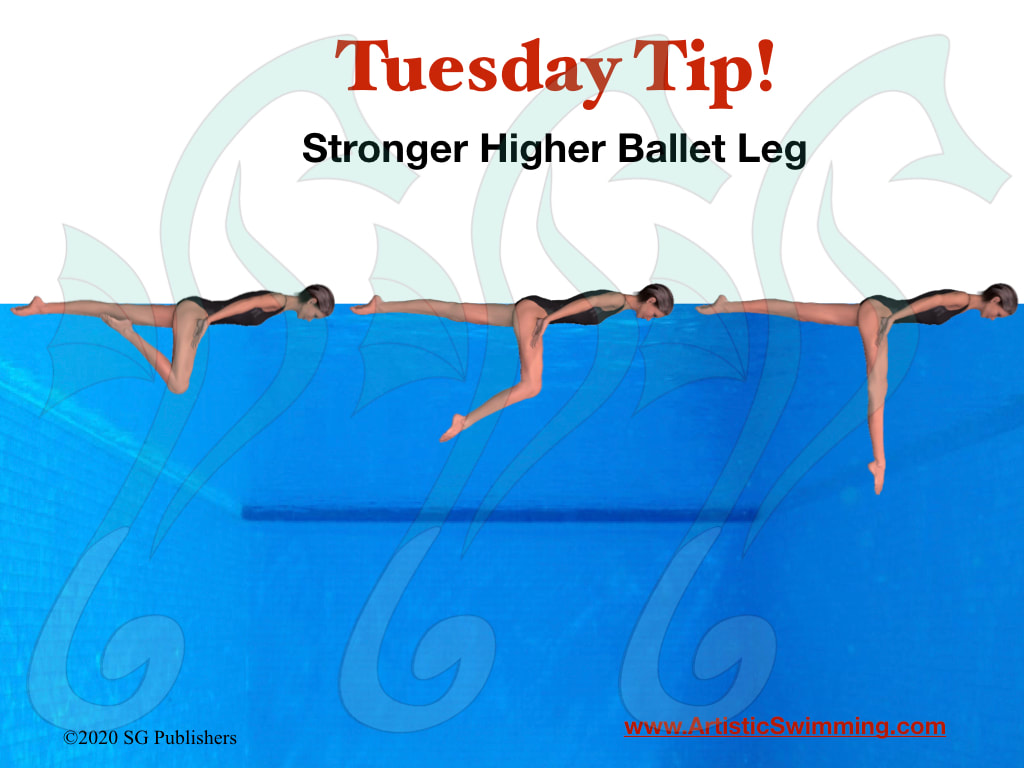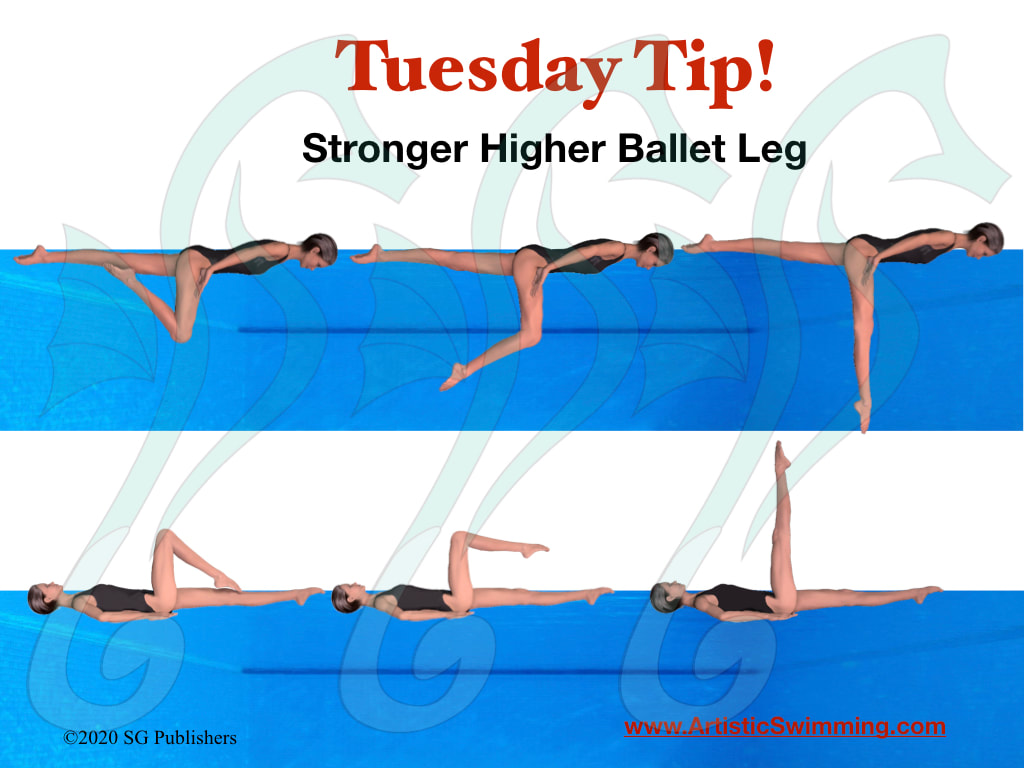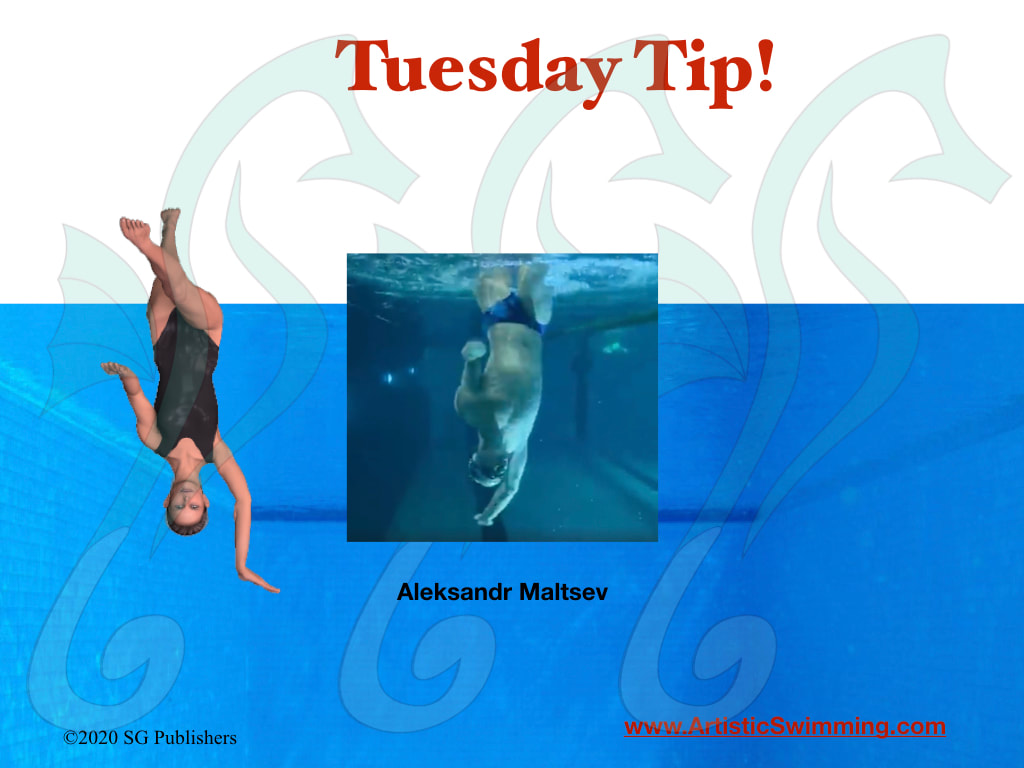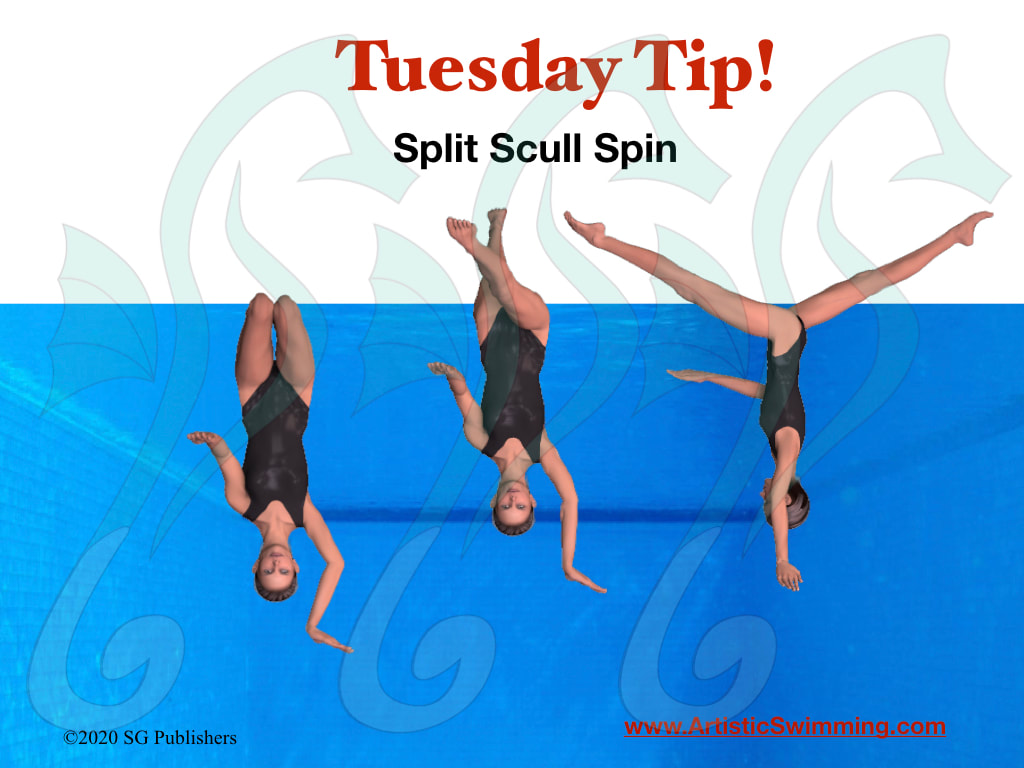Members- Click here for Members only Tuesday Tip info
Tuesday Tip Archives for Tuesday Tips #1-24
2nd Archive- Tuesday Tips #25-45
Tuesday Tip Archives for Tuesday Tips #1-24
2nd Archive- Tuesday Tips #25-45
#140 Tuesday Tip: PURPOSE
DO EVERYTHING FOR A REASON!
When you perform all of your laps, drills, figures, elements, routine swims, etc., make sure you have a purpose- a reason, an expected result, a goal, of doing every one. When you perform with a purpose in mind, your are more motivated and more focused. This is a very simple concept to help you improve faster. Say the purpose to yourself or aloud when you begin a set or drill, and repeat as your motivation and intensity wane.
Examples:
DO EVERYTHING FOR A REASON!
When you perform all of your laps, drills, figures, elements, routine swims, etc., make sure you have a purpose- a reason, an expected result, a goal, of doing every one. When you perform with a purpose in mind, your are more motivated and more focused. This is a very simple concept to help you improve faster. Say the purpose to yourself or aloud when you begin a set or drill, and repeat as your motivation and intensity wane.
Examples:
- Swimming laps for warm-up or swim sets: Purposes can be to improve cardio, improve arm and torso extension, improve catch on the water, improve arm and latissimus dorsi strength, improve streamlining, etc. Try applying one purpose for each day, each swim set, or even each lap of the pool.
- Sculling laps- improve technique, strength, endurance of specific muscles used in sculling, height, speed, etc.
- Figures: height, alignment, form, speed, etc.
- Routines: quickness, sharpness, pool coverage, height, synchronization, etc.
#139 Tuesday Tip: GOALS
GRAND
ORGANIZED
ACHIEVABLE
LOVE IT
SUSTAINABLE
Grand: Make your goals grand! After a year of unprecedented events and non-events, land training, in the pool- out of the pool, virtual everything, think grand when determining your goals. Even if you have been out of the pool for significant periods of time, you can still improve more than ever. Use your imagination and courage to determine great goals. Think Big!
Organized: Arrange your goals by priority and timelines. Which of your goals will have the greatest impact on your overall performance? Which is most important to achieve in order for you to reach your result goals? Make a list of your goals in order of priority. Divide your GRAND goals into smaller parts; what can you achieve or accomplish in a week, a month? 2 months? 6 months? 1 year?
Achievable: Even if your goals are grand, make sure they are possible for you. Sometimes the impossible becomes possible when you work hard enough and smart enough.
Love It: Pour your heart and soul into your new goals! Work until your body and mind are tired, recover, and start anew every day. You must love the goal and the process of achieving it, the drills, the laps, the repetitions, new skills, new knowledge… Make sure you love and enjoy working toward at least one or two of your goals. Not every goal may be fun to work toward, but having one or two that you really love and enjoy can keep you motivated for the rest.
Sustainable: Your goals should sustain your motivation and work ethic for days, weeks, months and years.
GRAND
ORGANIZED
ACHIEVABLE
LOVE IT
SUSTAINABLE
Grand: Make your goals grand! After a year of unprecedented events and non-events, land training, in the pool- out of the pool, virtual everything, think grand when determining your goals. Even if you have been out of the pool for significant periods of time, you can still improve more than ever. Use your imagination and courage to determine great goals. Think Big!
- How much higher can you get on a barracuda?
- How much faster can you swim?
- How far can you over split?
- Can you get both splits flat in the pool?
- How high can you sustain a vertical? A ballet leg?
- How many 360 revolutions can you complete for a spin?
- How quickly can you move in your routines?
- How much difficulty can you include in routines?
- How consistent can your execution of elements be?
Organized: Arrange your goals by priority and timelines. Which of your goals will have the greatest impact on your overall performance? Which is most important to achieve in order for you to reach your result goals? Make a list of your goals in order of priority. Divide your GRAND goals into smaller parts; what can you achieve or accomplish in a week, a month? 2 months? 6 months? 1 year?
Achievable: Even if your goals are grand, make sure they are possible for you. Sometimes the impossible becomes possible when you work hard enough and smart enough.
Love It: Pour your heart and soul into your new goals! Work until your body and mind are tired, recover, and start anew every day. You must love the goal and the process of achieving it, the drills, the laps, the repetitions, new skills, new knowledge… Make sure you love and enjoy working toward at least one or two of your goals. Not every goal may be fun to work toward, but having one or two that you really love and enjoy can keep you motivated for the rest.
Sustainable: Your goals should sustain your motivation and work ethic for days, weeks, months and years.
#138 Tuesday Tip: Balance & Speed
For those that are not able to be in the pool or are out for Christmas vacation, you can work on balance, speed alignment and extension on land.
- Stand with good extension up through the top of your head and long through both legs.
- Place your arms in support scull position.
- Lift one leg into a bent knee position, pause and extend.
- Repeat multiple times and then do with the other leg.
- To work on timing and speed, set to a metronome. Start slowly and then increase the speed.
#137 Tuesday Tip: Mixed Sculling
|
Combine two sculling methods to improve brain function and coordination.
|
#136 Tuesday Tip: Visualize & Scull
|
Add sculling to your visualization!
|
#135 Tuesday Tip: Scull & Movement Timing
|
|
Time your sculling with your leg movements!
Scull in when your leg bends to the bent knee and scull out when you extend up to the ballet leg. Try to start slowly and then play with different tempos. More for Members- Click Here |
#134 Tuesday Tip: Press or Scull??- for November 17th
Do ballet leg sets- alternating the presses and sculling. In reality, good sculling is some combination of vertical and horizontal movement of the hands and forearms. Use this drill of alternating to find your optimal sculling path.
#133 Tuesday Tip: Leverage in a Ballet Leg
|
Learn to utilize your horizontal leg for leverage to support your ballet leg!
More for Members- Click Here |
#132 Tuesday Tip: Flutter Kick to a Beat
|
Use your warm-up and training sets of kicking to improve timing, synchronization, and speed!
Turn on a metronome and time each kick to a beat.
More for Members- Click Here |
#131 Tuesday Tip: Warm-up
|
Warm up in Patterns
We suggest you do every part of your warm-up in patterns.
|
#130 Tuesday Tip: Backstroke Basics
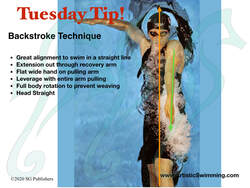
Photo by Feng Li/
Getty Images
Getty Images
#129 Tuesday Tip: Sculling
This image shows the location of the center of gravity with the orange circle. Note the position of the elbows placed equidistant from the center of gravity. Positioning the elbows in this manner creates a more balanced position and allows for strong and stable support in any type of scull.
Members Click Here for more
Members Click Here for more
#128 Tuesday Tip: Flat on the Surface
|
|
Getting a flat tabletop - both knees bent with shins flat along the surface (the name is not important) but this ubiquitous position is important to match in a duet or team.
Learn to find the flat tabletop quickly and easily with this simple drill. The hips are more open when the position is flat. Focus on the flat shins to get a position that is easily matched by all swimmers. More for Members Click Here |
#127 Tuesday Tip: One Arm Spins
|
|
As presented in earlier Tuesday Tips, there are multiple techniques that are effective for spins. And often, a swimmer will utilize different techniques in different positions, for different tempos, and for varying numbers of revolutions.
This is a drill to help you learn to utilize both arms effectively to spin so that you can be most efficient no matter the position, tempo, revolutions, etc.
|
#126 Tuesday Tip: Leg Flexors & Extensors
Move quickly, precisely and efficiently by utilizing the correct muscles to move the legs and effective focus points!
More for Members Click Here
More for Members Click Here
#125 Tuesday Tip: Torpedo Ballet Leg
Torpedo Ballet Leg
Doing lengths/laps of torpedo ballet leg is a great way to strengthen the buttocks, lower back, abdominals, shoulders and arms.
Try in the different positions as shown above- variance in the hip and lower back arch. Notice where you feel more strain or effort in the different positions.
When you are more arched, you should feel it more in the buttocks and lower back. This is what will help support you at a higher height.
Try to transfer this muscle engagement to a regular ballet leg in back scull.
Members - Click Here for More
Doing lengths/laps of torpedo ballet leg is a great way to strengthen the buttocks, lower back, abdominals, shoulders and arms.
Try in the different positions as shown above- variance in the hip and lower back arch. Notice where you feel more strain or effort in the different positions.
When you are more arched, you should feel it more in the buttocks and lower back. This is what will help support you at a higher height.
Try to transfer this muscle engagement to a regular ballet leg in back scull.
Members - Click Here for More
#124 Tuesday Tip: Support Scull Flipped
Try support scull with your arms flipped- or rotated so the palms are facing up rather than down!
Feel the difference in pressure on the arms and muscle engagement.
Support scull normal with palms facing down for 5-10 sculls then rotate the arms and do 5-10 sculls with palms facing up.
You may not ever actually do support scull this way to sustain a vertical or fishtail but it is great to learn how to get leverage with the arms in all directions.
Members Click Here for more
Feel the difference in pressure on the arms and muscle engagement.
Support scull normal with palms facing down for 5-10 sculls then rotate the arms and do 5-10 sculls with palms facing up.
You may not ever actually do support scull this way to sustain a vertical or fishtail but it is great to learn how to get leverage with the arms in all directions.
Members Click Here for more
#123 Tuesday Tip: Where do you do support scull?
|
What is the best position for support scull?
There is no "one" perfect arm position for support scull. It depends on the:
Try it! Try support sculling in different positions. Note the narrow or wide position of the forearms. It is difficult for some to get a full rotation and range of motion with the upper arms squeezed tightly in to the torso. Members- Click Here for more |
#122 Tuesday Tip: Narrow or Wide?
|
A simple drill to test if a narrow or wide sculling position is more efficient.
How does this apply to support scull? More for Members- Click Here |
#121 Tuesday Tip: Extension Drills
|
|
Improve your extension- learn to pull and lengthen out and up.
Drill 1:
A coach or another swimmer can help a swimmer pull out through their toes by gently pulling as the swimmer lengthens. More for Members - Click Here |
#120 Tuesday Tip: Hip & Leg Warm-up
A great warm-up for hips and legs:
- March in place lifting the knees as high as possible while keeping the hips and torso vertical.
- Bend the knees, lifting the heel towards the buttocks.
- Repeat 8 times on each leg, forward and back.
- Then 4 times on each leg, forward and back: 2 sets for a total of 8.
- Then 2 times forward, 2 times back, 4 sets for a total of 8.
- Do first on land and then repeat in the pool in the shallow end.
- For a longer workout, repeat land and water sets 2 or 3 times, set to a metronome. Speed up the tempo on consecutive sets.
#119 Tuesday Tip: How Leg Muscles Work
Another Drill to learn how to use the leg muscles properly! When muscles are used properly, there will be less unnecessary tension, less fatigue, with a longer and more effortless appearance.
When pulling up, use the back of the upper thigh, the upper hamstrings and the buttocks.
More for Members- Click Here
- Start in a bent knee vertical.
- Pull your knee down beneath the surface. Note: your foot can stay on your other leg or move away as pictured.
- Pull your knee up above the surface, sliding your toe along the shin of the straight leg.
- Repeat 10 times slowly. Pull down for 3 slow counts. Hold for 3 counts. Pull up for 3 slow counts. Hold for 3 counts.
- Now repeat more quickly. Pull down in 1 count. Hold for 4 counts. Pull up for 1 counts. Hold for 4 counts.
- Now repeat quickly without a hold. Pull down in 1 count. Pull up in 1 count. Repeat 10 times.
- Make sure to do each drill with both legs.
When pulling up, use the back of the upper thigh, the upper hamstrings and the buttocks.
More for Members- Click Here
#118 Tuesday Tip: Front & Back of Legs
|
Back of Legs- use the upper part of the hamstring into the buttocks to pull the leg back behind vertical or from pike to vertical.
Front of Legs- use the hip flexors- the upper quadriceps and iliopsoas and iliacus to pull the leg forward of vertical and to pull from the back to vertical. |
Do this easy drill to learn and feel how to use the front and back of the legs correctly.
|
#117 Tuesday Tip: Leverage & Orientation
|
|
Leverage & Orientation
Leverage, or "grab" on the water is key in everything in the water- and it is necessary to be in the water to really feel it, understand it and improve it. Do this simple drill to improve leverage with both arms to spin.
|
#116 Tuesday Tip: Get back your Orientation
|
Just a simple drill to get re-oriented in the water and being upside down again.
|
#115 Tuesday Tip: TIME
TIME
As some of you start to return to your pools and a somewhat regular training schedule, remember to take it slowly and easily. For most artistic swimmers that have participated for one to two years or more, you have probably never taken 8 to 12 weeks or even more off from training. As experienced swimmers, you understand that swimming engages different muscles, endurance, breathing and orientation than other land activities. No matter how closely you can mimic a water action like sculling with bands, balls or weights on land, there is nothing quite exactly like the feel of sculling in the water, the delicate balance of torso and limbs to find equilibrium in every position, the juggling of extension and muscular tension to discover just the right amount to look right and yet not be too tight and heavy in the water. It may take several days, a week or even two to completely regain your comfort and natural movements in the water. And with lots of land training, your muscularity, buoyancy and flexibility may have changed, adding yet another dimension to regaining your comfort and feel for the water.
Most importantly, be easy on yourself. You may not be at the same height in a vertical or a barracuda that you were 2 to 3 months ago. That’s ok. You will get back to where you were, it just takes time. Be realistic with your goals and expectations. Do not expect to be back to normal your first day back in the pool. Just enjoy being in the water again- the calm, cool peacefulness of floating on the surface or drifting beneath into the silence. Let the water drown out your fears and worries for just a moment, calm your mind and body like only being in the water can do.
Enjoy your pools once again! The water has not changed and it will bring you back to just where you want to be.
As some of you start to return to your pools and a somewhat regular training schedule, remember to take it slowly and easily. For most artistic swimmers that have participated for one to two years or more, you have probably never taken 8 to 12 weeks or even more off from training. As experienced swimmers, you understand that swimming engages different muscles, endurance, breathing and orientation than other land activities. No matter how closely you can mimic a water action like sculling with bands, balls or weights on land, there is nothing quite exactly like the feel of sculling in the water, the delicate balance of torso and limbs to find equilibrium in every position, the juggling of extension and muscular tension to discover just the right amount to look right and yet not be too tight and heavy in the water. It may take several days, a week or even two to completely regain your comfort and natural movements in the water. And with lots of land training, your muscularity, buoyancy and flexibility may have changed, adding yet another dimension to regaining your comfort and feel for the water.
Most importantly, be easy on yourself. You may not be at the same height in a vertical or a barracuda that you were 2 to 3 months ago. That’s ok. You will get back to where you were, it just takes time. Be realistic with your goals and expectations. Do not expect to be back to normal your first day back in the pool. Just enjoy being in the water again- the calm, cool peacefulness of floating on the surface or drifting beneath into the silence. Let the water drown out your fears and worries for just a moment, calm your mind and body like only being in the water can do.
Enjoy your pools once again! The water has not changed and it will bring you back to just where you want to be.
#114 Tuesday Tip: Visualize & Imagine
|
As many prepare to re-enter their pools after months away and others are still in the unknown realm, visualization is a great way not just to practice, but also to calm the mind and body. Proper visualization is not really that- it is not just visual. It involves all of the senses to create a world that is as close to real as possible. In a sense (many senses), it is a combination of memories and imagination.
Remember standing on the side of the pool, the feeling of the deck under your feet, the water in front of you with its gentle waves, the lanes on the bottom of the pool, the smell of the water, the sounds of other swimmers splashing or talking, the feel of the air around the pool- indoor or outdoor- the sun or the lights. You have just visualized and imagined the future. Now dive into the pool, feel your legs work to push off, your arms move overhead, your fingertips break the surface and you hear the splash (or crash) as you enter the pool. Feel the cool water cover your body, the sounds of the outside world are drowned out, you float weightlessly in the pool for a moment before resurfacing. Pull one arm back and roll to breathe as you begin to do freestyle. Can you feel the difference between the water and the air? Can you feel your arm and shoulder muscles begin to work as you pull forward? Can you feel your legs moving up and down in flutter kick? Can your hear the sounds of the water as your head turns down and turns again to breathe? Continue to visualize several laps of freestyle and then move on to the other strokes, backstroke, breaststroke and butterfly. Remember stretching on the side of the pool, the lengthen and release of muscles and tension. What does eggbeater feel like? How are the hips and legs rotating? What are you seeing as you extend up through your spine and out the top of you head? Who do you hear? Is it your own inner voice? Is it the water? Is it your coach or teammates? Smile as you remember being surrounded by the water and your team. Feel the peace and calm of being in the water. Enjoy this moment of imagining and remembering. Members CLICK HERE for more |
#113 Tuesday Tip: Timing & Strength
|
|
The muscle fibers strengthened during any exercise, drill or activity are dependent on the timing of the action. An increased speed will utilize different muscle fibers than a slower speed. That is why it is important to train movements at the desired performance speed. Train figures at the speed you want to perform and train routine parts at the same speed they will be performed to the music in the routine.
By doing a simple bicep exercise, you can feel the difference in your arms while training different muscle fibers- and gain control of your arm speeds.
|
#112 Tuesday Tip: Sculling Games
Scull normally for 20-30 seconds then switch and scull arms in the same direction for 20-30 seconds. Then try setting the sculling tempo to a metronome at 60 beats per minute up to 120 beats per minute. Scull normal for 10 seconds then switch to the same direction. Switch back and forth multiple times. Try to replicate your sculling as close as you can to sculling in the pool. If possible, lay on a bench to place your arms as they would be in a back layout or ballet leg.
Members Click Here for more
Members Click Here for more
#111 Tuesday Tip: Sculling in a Small Space
|
You can work on your sculling without a pool!
|
#110 Tuesday Tip: Spin & Focus
|
You can improve your orientation and awareness through land drills.
|
#109 Tuesday Tip: Hip Flexibility Exercises
Often flexibility exercises/ stretches target the back of the legs more than the front. Good flexibility of the front of the hips- the hip flexors that include the quadriceps, iliacus and iliopsoas muscles is key to good splits and balance in the body. If you are overly flexible in the hamstrings but tight in the hip flexors, this can lead to injury and overuse of some muscles.
|
Stand with good extension and alignment. Pull one leg backward and point the toes so the toes are just resting on the ground.
|
Lift the leg a small amount to the back. Do in small pulses at a fairly quick tempo. Try to hold the toes off the floor the whole time or just let the toes touch. You do not want the foot to drop heavily to the floor. Repeat in sets of 10 or 20 for 2 to 3 sets.
Keep good extension and spinal alignment. |
Repeat the same exercise lifting the leg higher- about half way to horizontal.
|
Repeat lifting the leg back as high as you can while maintaining good vertical alignment.
Make sure to keep the hips pressed forward so as not to allow piking in the hips. Make sure to repeat sets with both legs. |
After doing sets at a rapid tempo, lift the leg and hold for 2 to 3 counts before lowering and repeating. Repeat again in sets of 10 to 20 repetitions.
For those less flexible- lift the back leg onto a lower surface like a foot stool, low bed or bench. Always keep the back leg straight and extended.
More for Members- Click Here
#108 Tuesday Tip: Fishtail to Vertical Extension
|
Improve your fishtail to vertical transition.
|
#107 Tuesday Tip: Ideas to Train at Home
|
In this uncertain time, it can be helpful to try to maintain regular physical activity for all athletes and particularly for those trying to maintain their competitive form and physical training. Below are some ideas to help you train at home.
Ballet Legs Do ballet legs on land. These can be slower for figure competition training working on smooth muscle control, extension, tempo, etc. Or rapid routine ballet legs- do all of your routine ballet legs at the correct tempo- do with the music. Flutter Kick Flutter kick in sets on land. This can also be done slowly or at a rapid tempo. Set to a metronome to keep a consistent tempo. (Metronome apps can be downloaded.) Do on the back and front. Land Drill Practicing routines on land can be used for more than just setting and reviewing counts. Use the effort and energy that is required in the pool in your land drill. Imagine that you are at a competition pool. Extend, emote, perform! Stay healthy everyone! |
#106 Tuesday Tip: Extension with Quick Legs
|
|
Lift from fishtail to Vertical
|
#105 Tuesday Tip: Balanced Core Strength and Control
|
|
A Simple drill to work on the front and back of the core: the back is equally important as the front- the abdominals and often ignored. the back is the key strength in a ballet leg and critical for a balanced vertical.
Members Click Here for More |
#104 Tuesday Tip- Extension Drill
|
Extension is more than just a good toe point or straight knees. Extension is the length of your movements, the energy you exude, and the command of your performance. Learning to lengthen out from your center while maintaining good alignment is the key.
Try this simple drill to improve extension.
|
#103 Tuesday Tip - Support Scull Path
There are 3 general paths for support scull- the scull that is typically used to support vertical airborne weight.
- Flat Scull Path: The flat scull path is almost completely flat through the range of motion from directly out to the sides of the torso to in front of the shoulders. There is little vertical range. This method of sculling is supported by the brilliant research led by Miwako Homma - published here https://www.tandfonline.com/doi/full/10.1080/14763141.2019.1671485
How do elite artistic swimmers generate fluid forces by hand during sculling motions?
Miwako Homma, Yuma Okamoto & Hideki Takagi - Oval Scull Path: The inner most part of the scull is about the same as the Flat scull, however on the outward motion the hands reach up toward the surface. In the past this was generally thought to be a figure 8 path with a small "loop" on the inner transition. Past video studies underwater indicated that many swimmers did utilize this figure 8 path with great results.
- Vertical Scull Path: The path of the forearms is nearly vertical with minimal in and out motion. This can be observed in many novice swimmers as they learn to generate lift force by sculling. Often there is little actual sculling, with force more dominated by drag forces- or simply pressing the arms down to gain upward leverage for the torso and legs. However, this path has been used with great success by some swimmers- probably they have learned to successfully scull through this path, allowing them to generate consistent and powerful lift force. Note that Aleksandr Maltsev used this type of scull with one arm while performing his sustained spin using a split arm scull. (shared on our Facebook page on February 3rd.)
#102 Tuesday Tip - Stronger Higher Ballet Leg
Stronger Higher Ballet Leg
This is just a simple drill to focus on your back instead of your front side in a ballet leg.
This is just a simple drill to focus on your back instead of your front side in a ballet leg.
- Get into a front layout and do your ballet leg extending down toward the bottom of the pool.
- Focus on keeping your back flat at the surface.
- Roll over in each position into a normal ballet leg- keeping your focus on your back side.
#101 Tuesday Tip - Split Scull Spin
Split Scull Spin
Check out the video we shared on Facebook yesterday from Aleksandr Maltsev- the great world champion in mixed duet from Russia. It is a great video with an underwater view of a sustained spin using a split scull technique.
Check out the video we shared on Facebook yesterday from Aleksandr Maltsev- the great world champion in mixed duet from Russia. It is a great video with an underwater view of a sustained spin using a split scull technique.
- The left - leading- arm is in support scull.
- The right arm is in overhead torpedo.
- Both arms are in close to his torso.
- The left arm appears to provide more support for sustaining height.
- Try this spin- you must try to succeed.
- Try first in a tabletop position with no airborne weight to sustain.
- Work on the sculling technique and speed of spin in the tabletop position.
- Recognize that there is not one perfect sculling technique nor arm position for sculling. Every body is different in terms of buoyancy, muscle mass, limb length, center of gravity, lung volume, arm strength, etc. So sculling techniques must vary to accommodate these differences.
#100 Tuesday Tip - Breathe
Breathing is a critical skill - a fundamental- for an artistic swimmer, often overlooked and frequently ignored in training. We take it for granted.
How do you improve your breathing?
How do you practice it?
Our bodies- our muscles and organs and brain- need oxygen to function and perform.
Improving oxygen uptake is two-fold:
The Process of Breathing
We do take it for granted that we all know how to breathe- without breathing we cannot live.
Are we breathing in an optimal manner?
When we breathe during physical activity are we breathing efficiently and effectively?
Things to look for in swimmers:
Breathing is a critical skill - a fundamental- for an artistic swimmer, often overlooked and frequently ignored in training. We take it for granted.
How do you improve your breathing?
How do you practice it?
Our bodies- our muscles and organs and brain- need oxygen to function and perform.
Improving oxygen uptake is two-fold:
- The process of breathing
- The cardiovascular function that distributes oxygen to the different parts of the body.
The Process of Breathing
We do take it for granted that we all know how to breathe- without breathing we cannot live.
Are we breathing in an optimal manner?
When we breathe during physical activity are we breathing efficiently and effectively?
Things to look for in swimmers:
- When the swimmer inhales, where does the breath appear? Do the shoulders raise? Do the abdomen and chest cavity expand?
- Is the swimmer gasping for air?
- Is the swimmer exhaling or blowing bubbles out during a figure or routine?
#99 Tuesday Tip
BELIEVE
After working with athletes in a variety of sports over many years, perhaps the strongest determinant of success is belief. Belief in yourself and belief of someone or a group of people around you, the athlete. It is amazing how strong an impact the belief or lack of belief can have on performance, motivation, determination, persistence… An athlete develops a belief - or lack of belief- in themselves at an early age by the words, looks, and feelings of those around them. The people who can have an enormous impact are parents, siblings, coaches, teachers, teammates, friends and relatives. That belief from others can be shown in many ways- words of support that really carry a feeling of strength and belief, looks of love, approval and care, interest in training, skills and performances, support when setbacks - big or small- occur. And perhaps most importantly, the feelings of belief and support. We have an innate ability to sense the feelings of others; we know when someone believes in us or not. Words can rarely cover the feelings we sense or the actions we see.
Belief can be built or destroyed by the simplest of words- often not intended to help or hinder but felt deeply by the athlete. We can all remember a situation in a classroom or at a training when a very impactful event occurred - a teacher or coach said something to support or to maybe humiliate (correct, belittle, or discourage) us. The power of one interaction when the athlete is vulnerable can have long lasting affects.
Champion athletes are not always the most confident people, but they are confident in their ability to work hard, to be persistent, to be determined. And one of the simplest things that happened for many is that “nobody ever told them they couldn’t.” No-one ever said; you are not good enough, you will not make it, that goal is too hard, the Olympics is just a dream…
Nobody ever stopped their dreams. For the athlete, surround yourself with someone or a group of people that really believe in you- believe in your dreams, your strength to persist and your motivation. For the coach, show your belief in your athletes and understand that some will not have that belief and support from others around them.
BELIEVE
After working with athletes in a variety of sports over many years, perhaps the strongest determinant of success is belief. Belief in yourself and belief of someone or a group of people around you, the athlete. It is amazing how strong an impact the belief or lack of belief can have on performance, motivation, determination, persistence… An athlete develops a belief - or lack of belief- in themselves at an early age by the words, looks, and feelings of those around them. The people who can have an enormous impact are parents, siblings, coaches, teachers, teammates, friends and relatives. That belief from others can be shown in many ways- words of support that really carry a feeling of strength and belief, looks of love, approval and care, interest in training, skills and performances, support when setbacks - big or small- occur. And perhaps most importantly, the feelings of belief and support. We have an innate ability to sense the feelings of others; we know when someone believes in us or not. Words can rarely cover the feelings we sense or the actions we see.
Belief can be built or destroyed by the simplest of words- often not intended to help or hinder but felt deeply by the athlete. We can all remember a situation in a classroom or at a training when a very impactful event occurred - a teacher or coach said something to support or to maybe humiliate (correct, belittle, or discourage) us. The power of one interaction when the athlete is vulnerable can have long lasting affects.
Champion athletes are not always the most confident people, but they are confident in their ability to work hard, to be persistent, to be determined. And one of the simplest things that happened for many is that “nobody ever told them they couldn’t.” No-one ever said; you are not good enough, you will not make it, that goal is too hard, the Olympics is just a dream…
Nobody ever stopped their dreams. For the athlete, surround yourself with someone or a group of people that really believe in you- believe in your dreams, your strength to persist and your motivation. For the coach, show your belief in your athletes and understand that some will not have that belief and support from others around them.
#98 Tuesday Tip: Improve Every Day
Improve Every Day
Stay focused on the “DOING”. Immerse yourself in every lap, drill, figure, stroke, hybrid, etc.
What does that mean?
Stay focused on the task at hand- get better at every task. Use a complete strategy of visual, auditory and kinesthetic aspects. See it, say something to yourself, and feel it.
For example:
Swimming freestyle-
When you swim a lap of freestyle, repeat one or two strategies for each stroke. For example, say reach or extend, see your fingertips reaching toward the end of the pool, and feel the extension from your hip out through your fingertips.
More for Members- Click Here
Barracuda Thrust
How can you work on improving your thrust on every repetition?
See your body unrolling rapidly. See your toes shooting up to the ceiling or sky. See maximum height with your hips, waist and chest above the surface.
Say to yourself: “Up, Extend, Quick.”
Feel the rapid rise to height. Feel the lightness of your body.
Every repetition of a barracuda, use one or more of these strategies. The mind can move quickly between strategies- or distractions. If a distraction enters your mind, allow it and then move back to the strategies.
Improving on every repetition is not an easy task but the habit can be developed. It is ok to wander momentarily and then come back to the task. Do not be too difficult on yourself if you wander in your thoughts, just return to the strategies. Begin with simple laps, drills, and skills and gradually progress to the longer combinations of figures, technical elements, routine parts and eventually entire routines.
Stay focused on the “DOING”. Immerse yourself in every lap, drill, figure, stroke, hybrid, etc.
What does that mean?
Stay focused on the task at hand- get better at every task. Use a complete strategy of visual, auditory and kinesthetic aspects. See it, say something to yourself, and feel it.
For example:
Swimming freestyle-
- See yourself extending through your fingertips to the opposite end of the pool.
- Say to yourself- reach or extend.
- Feel your torso and arm lengthening from your hip out to the end of the pool.
- See your hand and forearm “catching” the water.
- Say to yourself “grab or pull”
- Feel your hand and arm establish catch as if holding onto something solid.
When you swim a lap of freestyle, repeat one or two strategies for each stroke. For example, say reach or extend, see your fingertips reaching toward the end of the pool, and feel the extension from your hip out through your fingertips.
More for Members- Click Here
Barracuda Thrust
How can you work on improving your thrust on every repetition?
See your body unrolling rapidly. See your toes shooting up to the ceiling or sky. See maximum height with your hips, waist and chest above the surface.
Say to yourself: “Up, Extend, Quick.”
Feel the rapid rise to height. Feel the lightness of your body.
Every repetition of a barracuda, use one or more of these strategies. The mind can move quickly between strategies- or distractions. If a distraction enters your mind, allow it and then move back to the strategies.
Improving on every repetition is not an easy task but the habit can be developed. It is ok to wander momentarily and then come back to the task. Do not be too difficult on yourself if you wander in your thoughts, just return to the strategies. Begin with simple laps, drills, and skills and gradually progress to the longer combinations of figures, technical elements, routine parts and eventually entire routines.
#97 Tuesday Tip: The Contradiction of Mind Set
The Contradiction of Mind Set
Champion athletes rarely have a set mind. They are adaptable, open to new ideas and change. Champions make adjustments. Goals are fluid and flexible on a daily basis- going further when progress is quick and perhaps slowing down when progress inches forward.
A mind set is only an asset if it makes you productive. The more important thing is DOING. What are you doing to become successful and productive? A positive mind set can help you feel better, and this may help you be more successful, but only if you are doing something.
More for Members Click Here
Champion athletes rarely have a set mind. They are adaptable, open to new ideas and change. Champions make adjustments. Goals are fluid and flexible on a daily basis- going further when progress is quick and perhaps slowing down when progress inches forward.
A mind set is only an asset if it makes you productive. The more important thing is DOING. What are you doing to become successful and productive? A positive mind set can help you feel better, and this may help you be more successful, but only if you are doing something.
More for Members Click Here
#96 Tuesday Tip: Achieve your 2020 Goals
|
Positive: Positive goals, positive inner voice, positive instruction.
Persistent: Work diligently and with focus toward your goals. Realistic: Set realistic goals, set achievable goals over which you have control, set goals for training and competition. Humble: Recognize the skills of others and the contributions of all toward an individual's and a team's success. More for members Click Here |
More tips for Paid Members Only Here
Tuesday Tips #48-95 in the 3rd Archive Tuesday Tips
Tuesday Tips #25-47 in the 2nd Archive Tuesday Tips
Tuesday Tips #1 - 24 in the Tuesday Tips Archives
This website uses marketing and tracking technologies. Opting out of this will opt you out of all cookies, except for those needed to run the website. Note that some products may not work as well without tracking cookies.
Opt Out of Cookies